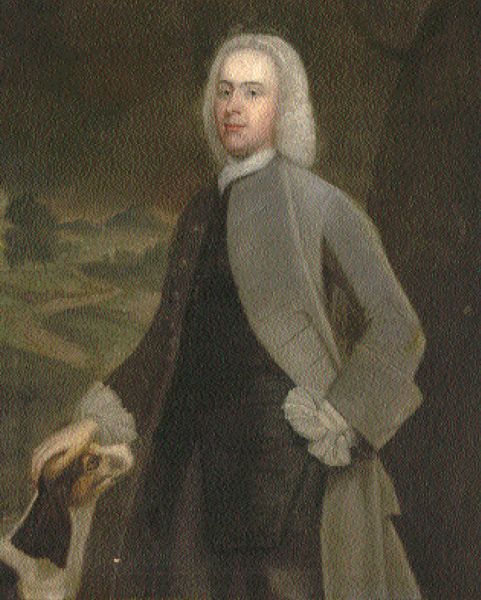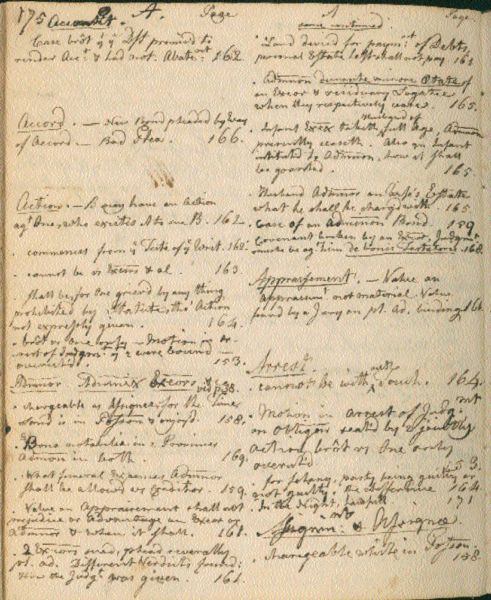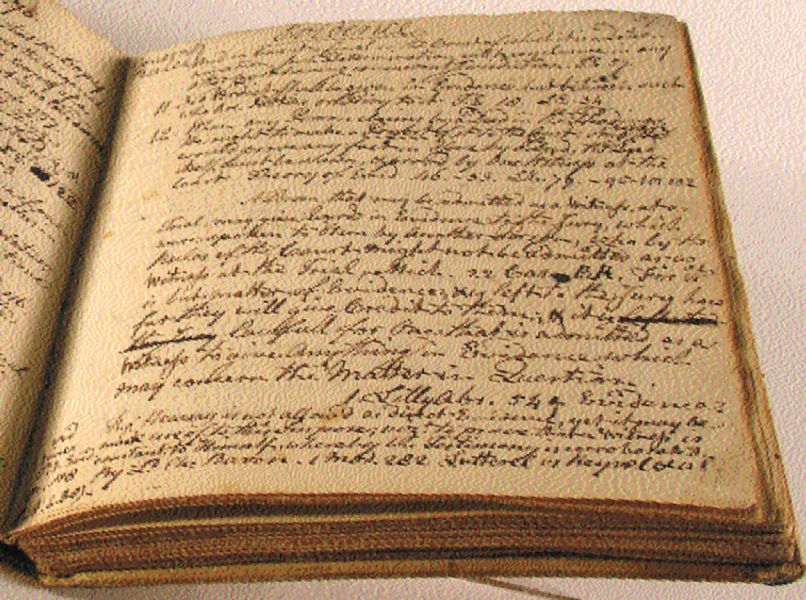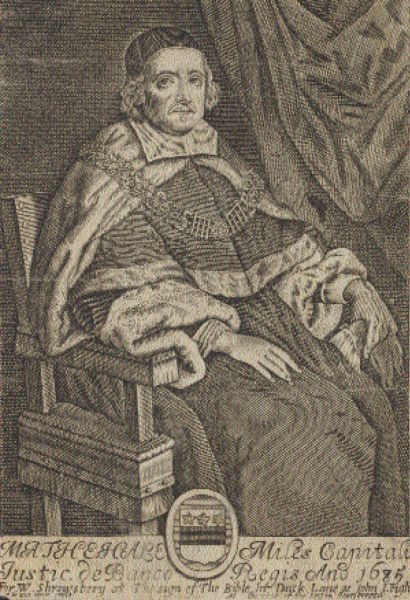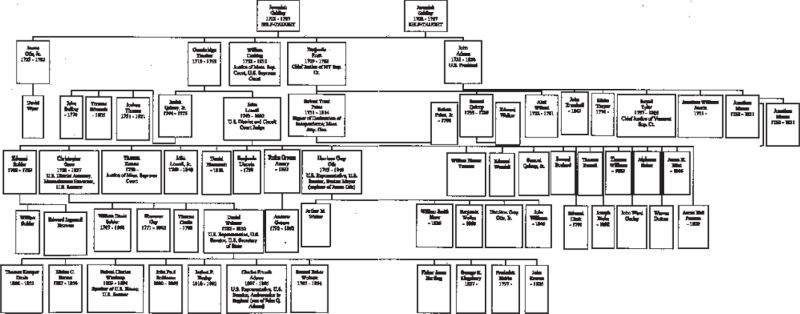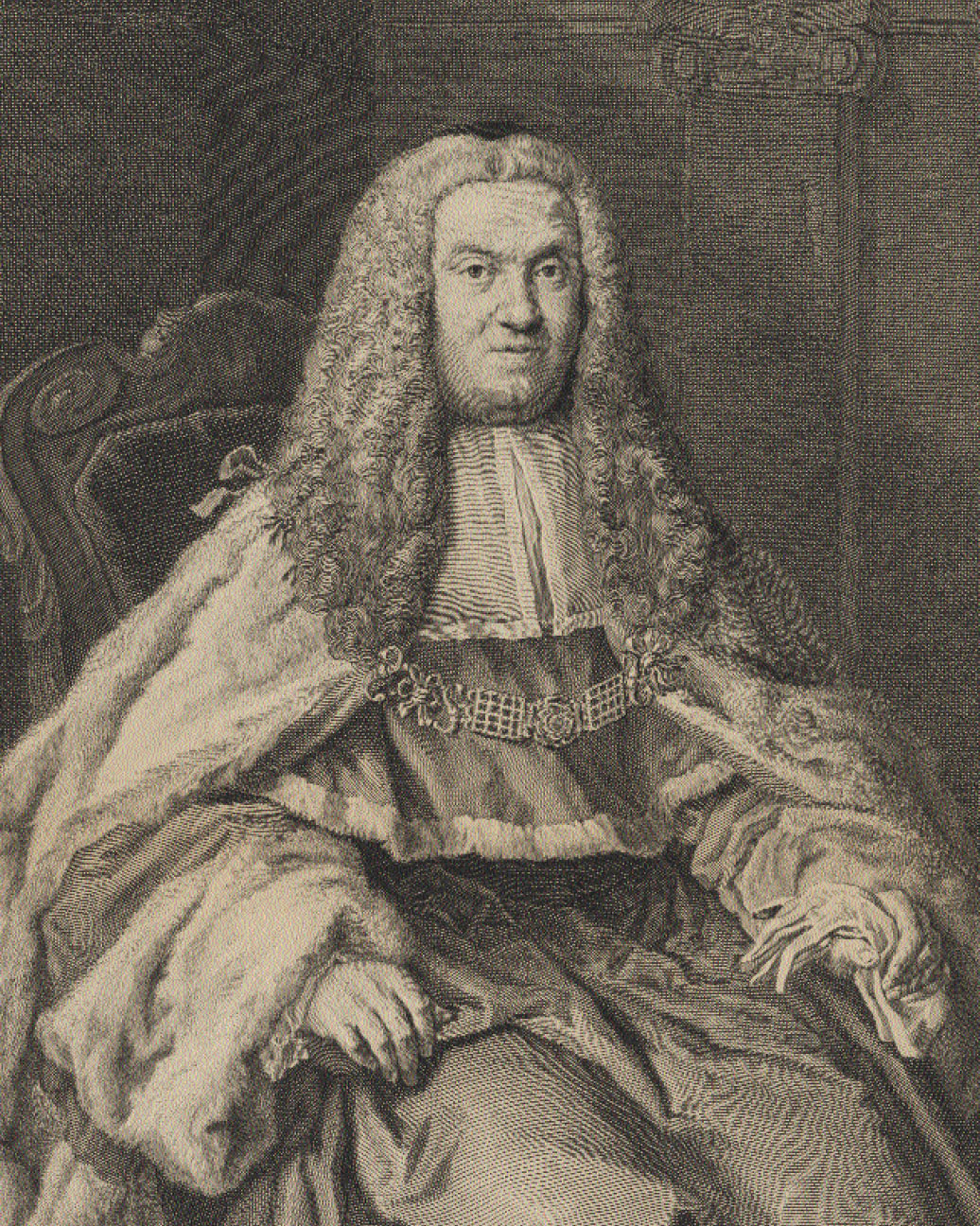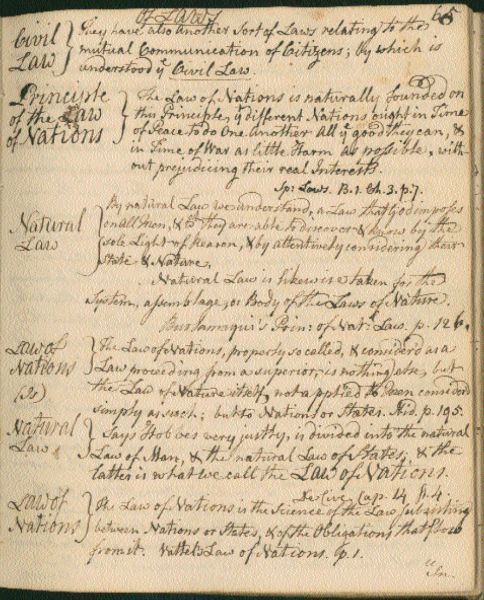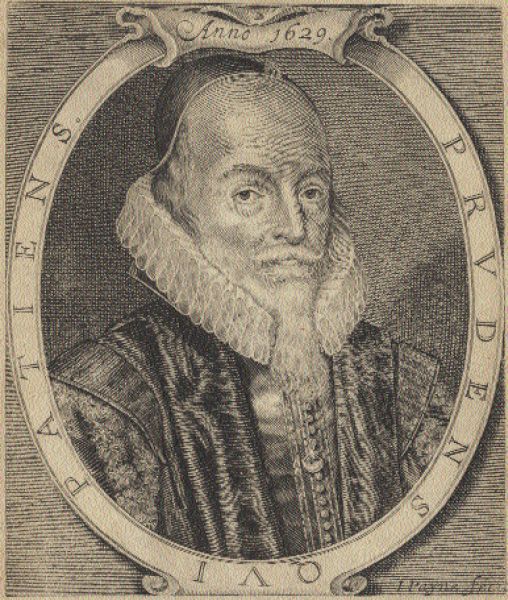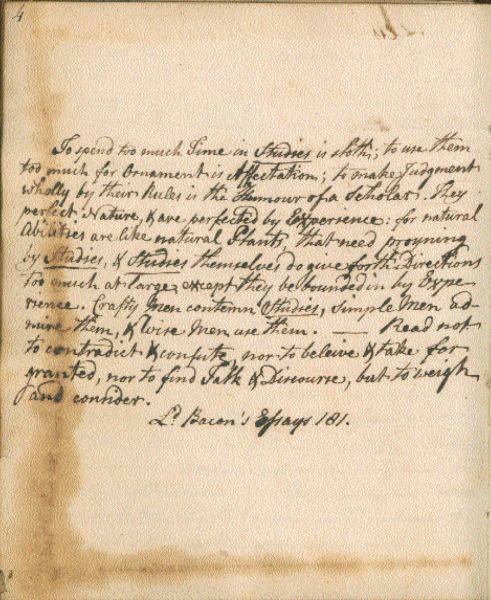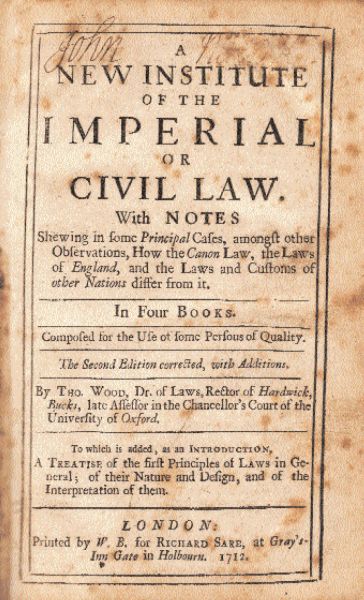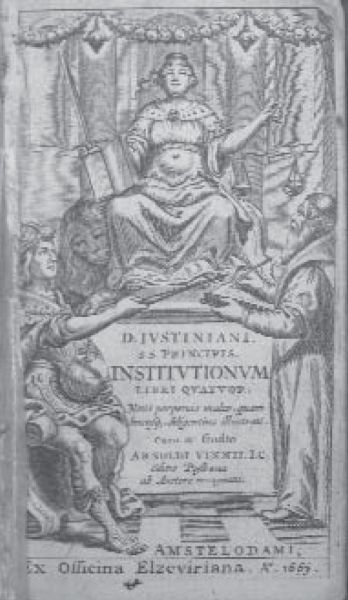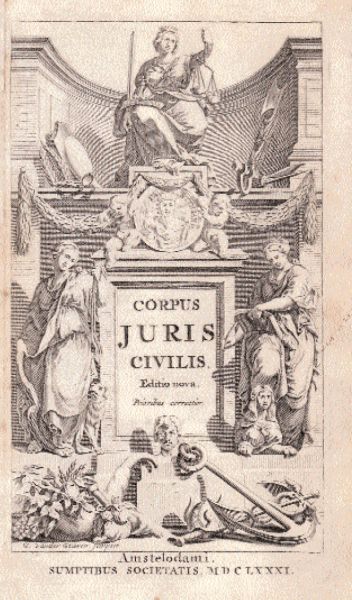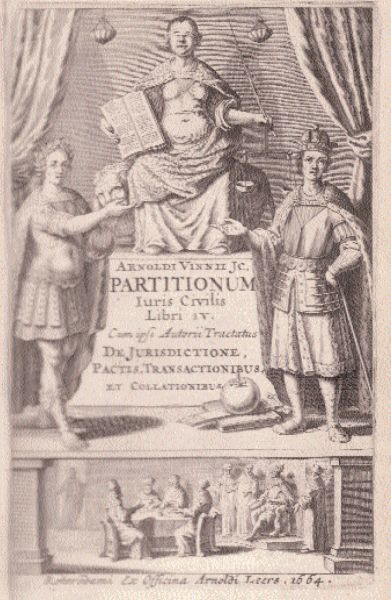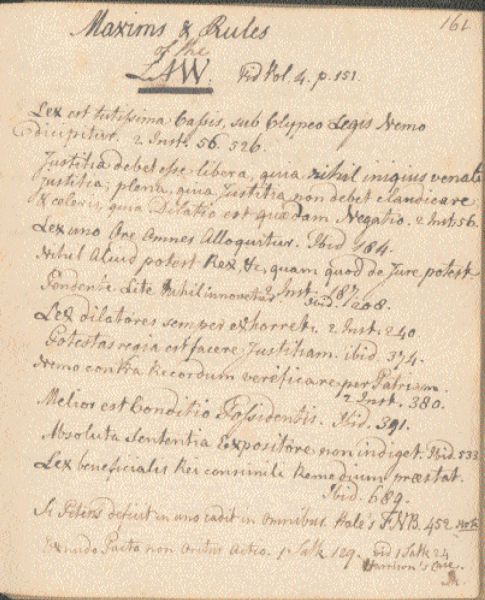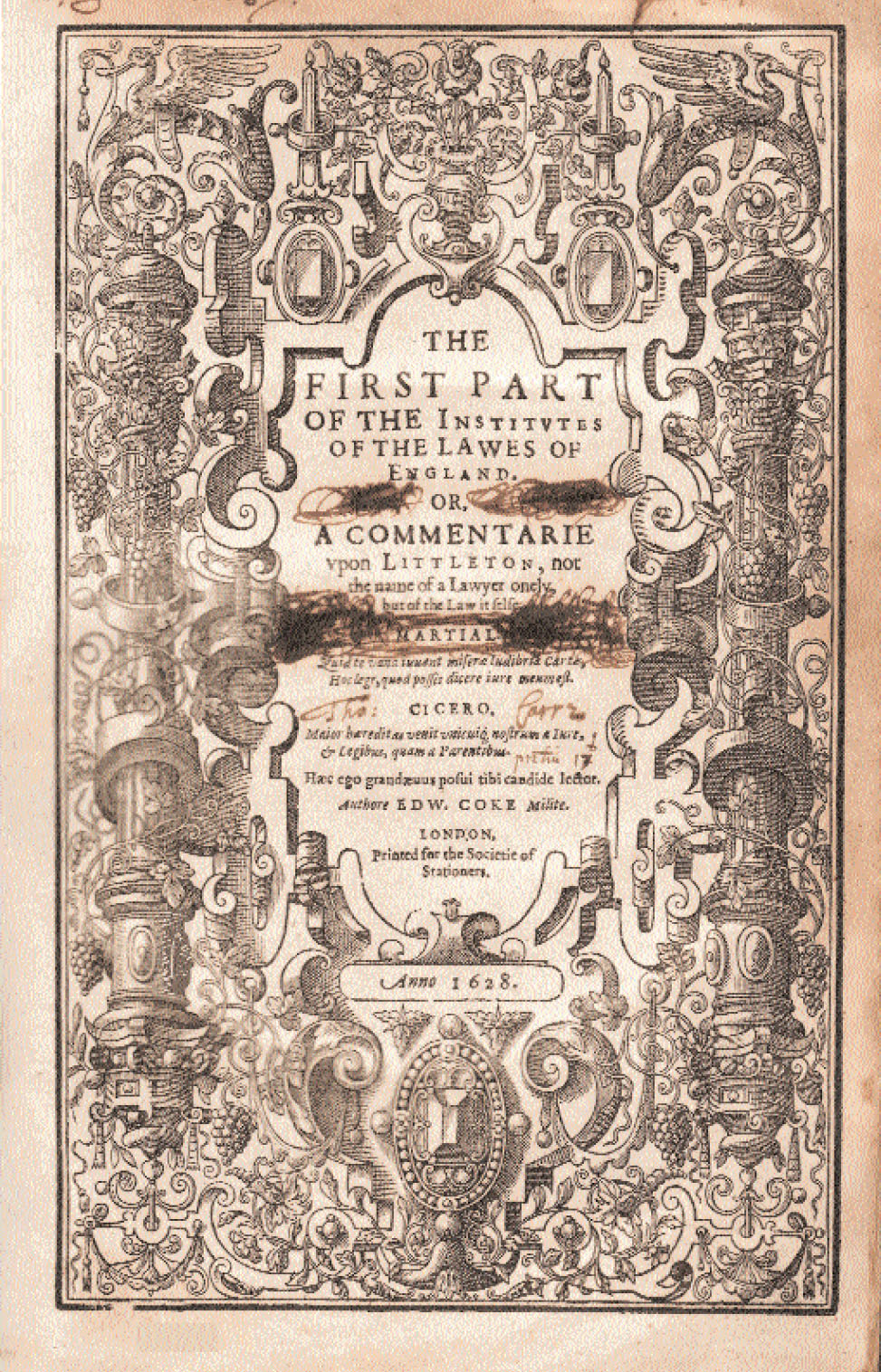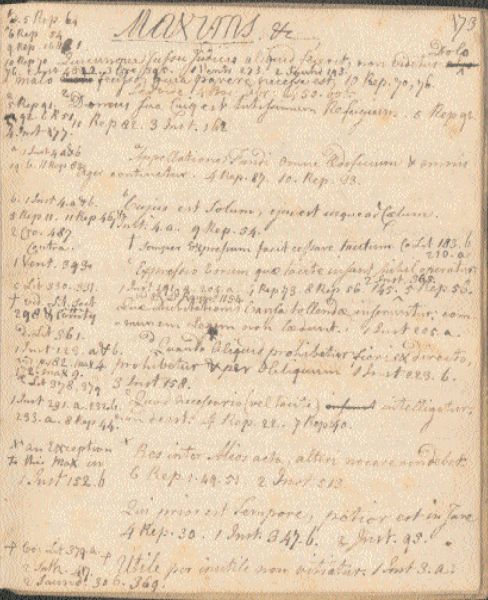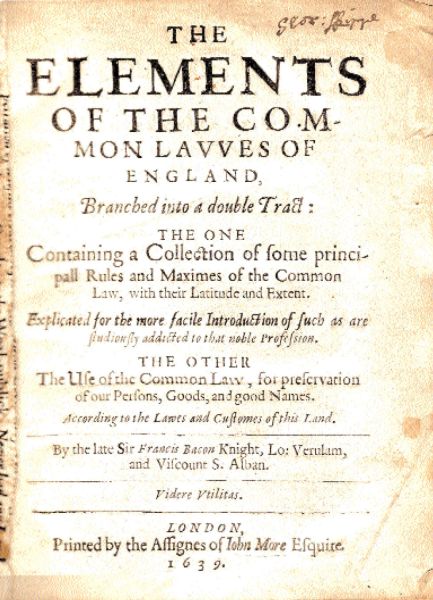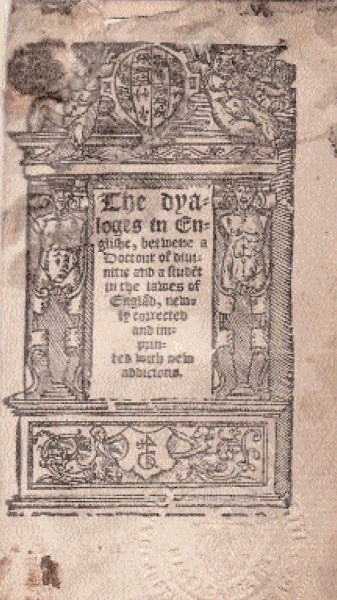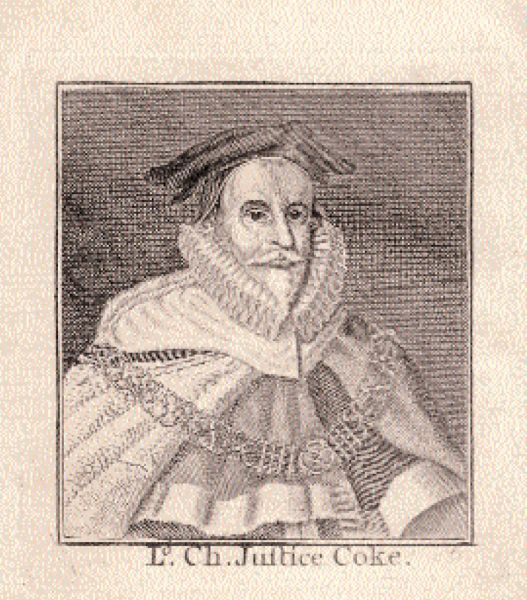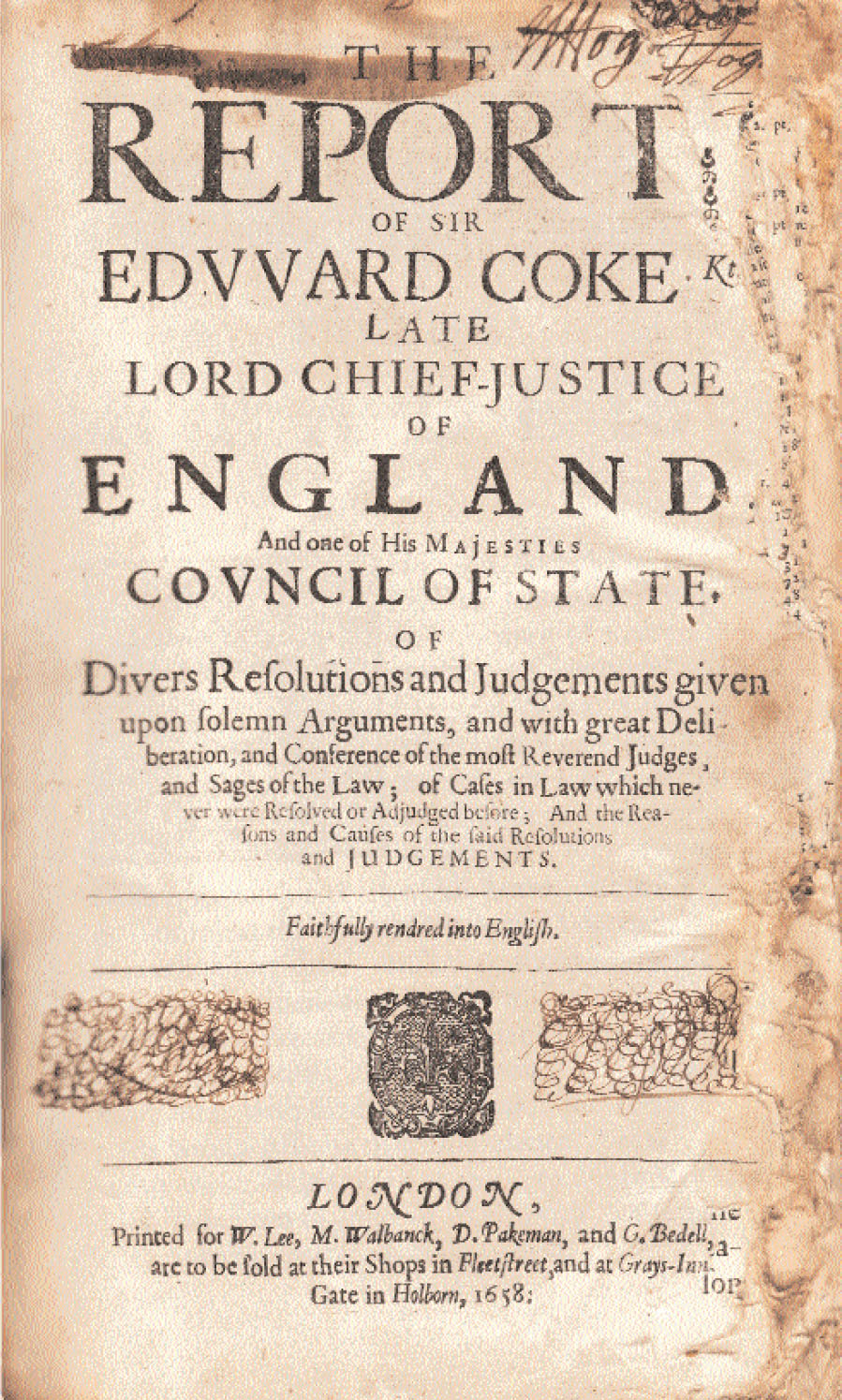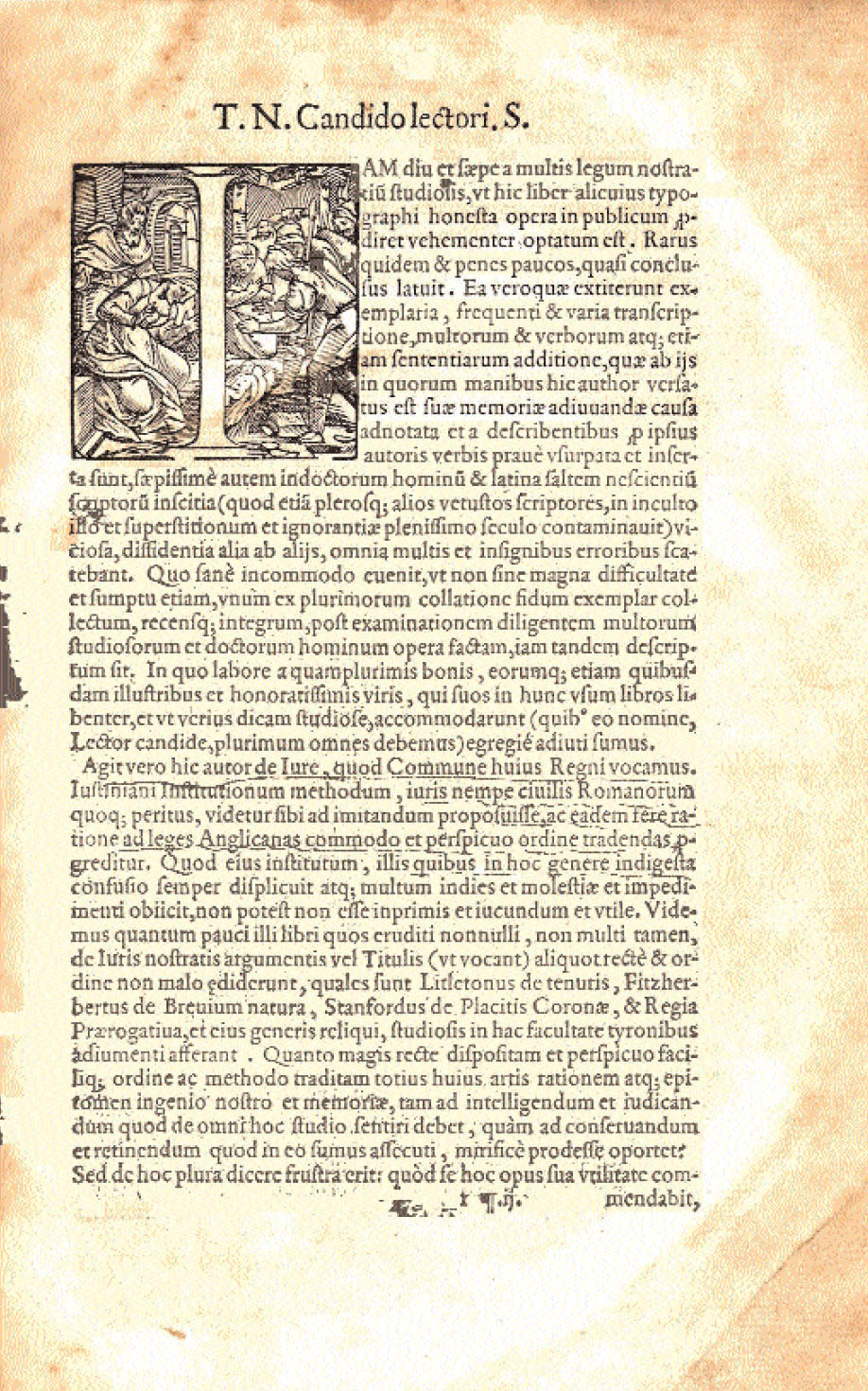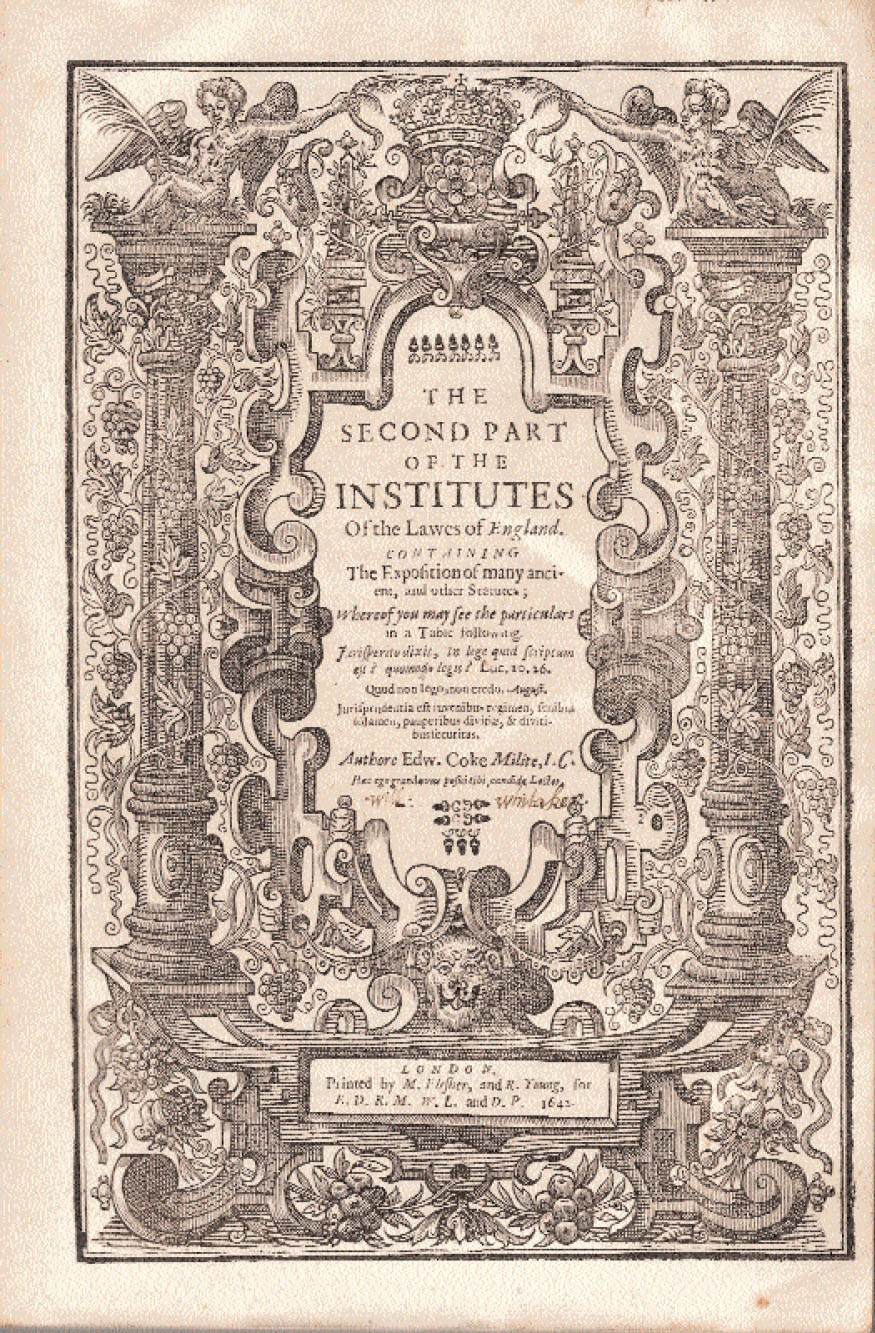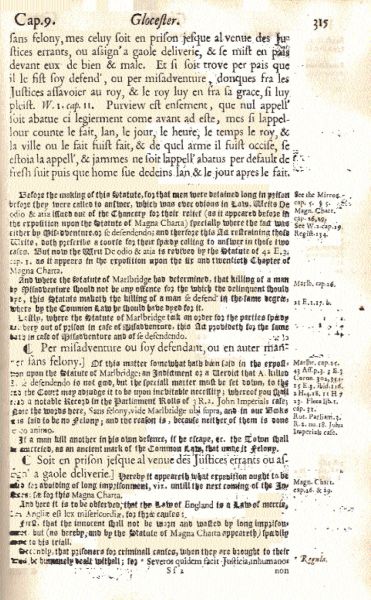illustration 1. Quincy’s pupil master, Oxenbridge Thacher (1719‒1765) by Robert Feke, or In the manner of Robert Feke (c. 1748 or 1749). Thacher was a leading member of the Boston bar. At only twenty-one, Quincy assumed Thacher’s law practice upon his teacher’s death in 1765. See “The Making of a Patriot,” by Neil Longley York in Quincy Papers, vol. 1, p. 17. Image courtesy of Yale University Art Gallery, Gift of Thomas Thacher, B.A. 1938. See also note 42, infra. My thanks to Kevin Cox for tracking down the original portrait at Yale University, and to David Warrington, for locating a copy at Harvard Law School.
INTRODUCTION
The Legal Education of a Patriot:
Josiah Quincy Jr.’s Law Commonplace
Daniel R. Coquillette*
Much has been written about the history of American legal education. And almost all of it is about law schools. Literally hundreds of volumes have described the hundreds of professional law schools established in North America, from the prototype Litchfield Law School (1784 to 1833) to the newly published account of the “Dark Ages” of the 1960s through the early 1980s at Yale Law School.1 Even the different, but related, phenomenon of teaching law to undergraduates as a “liberal art,” symbolized Thomas Jefferson’s establishment of the Professorship of Law and Police at The College of William and Mary in 1779, has been carefully chronicled.2 But the lawyers who founded this nation and defended the early Republic, famous lawyers, learned most of their law a very different way. Take Massachusetts as an example. John Adams, Robert Treat Paine and James Otis Jr. were great lawyers, but they never attended a law school. Neither did Patrick Henry, Joseph Story, James Monroe or Thomas Jefferson. John Marshall was another, if one overlooks a brief tuition from George Wythe while Wythe was at William and Mary.3 Story and Jefferson established great law schools, but they did not learn law that way themselves.
Of course, the primary method for learning law in the American colonial period was apprenticeship. That would be true for much of the next century, too. Perhaps because most books about legal education are written by law professors, apprenticeship as a pedagogy and a course of study has been widely overlooked and belittled.4 The popular conception is that apprentices were educated by chance, picking up whatever learning they could while copying documents and running errands for their indifferent masters.5 Possibly there would be useful books in their masters’ libraries, possibly not. Possibly they would have the chance to browse in whatever books there were, but it would all be happenstance. Certainly, whatever instruction there was would be practical, not theoretical, and would focus on local, not national, law and certainly not—even more inconceivable—international law!
But the history of the pre-revolutionary bar seems most odd if this was truly the case. Take, for example, the legal world of 1773 described in Quincy’s Southern Journal, set out Volume 3. While there was an occasional lawyer who had “experience” at the remarkably lax Inns of Court in London, particularly in the South, most of Quincy’s professional acquaintances in South Carolina, North Carolina, Virginia, Delaware and Pennsylvania were taught by apprenticeship.6 Yet there was a clear sense of a legal elite, with a firmly established professional identity. John Adams’s Diary paints a similar picture—a self-defined and small professional elite, set apart by education and skill from a host of “petty foggers.”7 It is true Quincy had a low opinion of the training of some of the Southern lawyers he met, particularly in South Carolina, but that, in itself, speaks of professional standards.
My thesis is that, at its best, elite legal apprenticeship had both a pedagogy and a curricular structure that was far from random. It was neither “local” nor necessarily “practical” in its forms, and it could include comparative study, particularly of Roman law. This education may not have been ideal, nor uniformly excellent, but given a good tutor and a good student it was rigorous enough to explain the strong sense of legal professionalism to be found in America before the Revolution.
Why has this been so overlooked? First, the institutional records of this type of legal education are relatively scarce. The few that have survived tend to be the legal commonplace books of the apprentices, and these, although not rare, have rarely been published. This alone makes Quincy’s Law Commonplace of 1763 an important document, and it has never been transcribed or published until now. Unless included in the papers of an Adams or a Jefferson, such records have usually been inaccessible to all but a handful of scholars.8
But there is a further reason. Most American legal historians, even those who are not trained as lawyers, have been subconsciously “brainwashed” by two powerful, and complementary, visions of legal education, which have been superimposed on each other. The first was the vision of Joseph Story, and the second of Christopher Columbus Langdell.
Joseph Story (1779–1845) was, at age thirty-two, the youngest Justice of the Supreme Court ever appointed and, at age forty-nine, the “Savior of Harvard Law School.” Founded by the proceeds of the will of Isaac Royall in 1817, the Harvard Law School had previously failed to compete effectively with apprenticeship and was down to one student in 1829.9 A generous donor, Nathan Dane, agreed to establish a newly endowed professorship, but only on the condition that Story would take it. Without abandoning his judicial career, Story took this position as well.
He had a simple formula for success. Harvard Law School must become an elite, national institution, drawing students from all states. To do that, it must offer broad instruction in legal theory, legal history, comparative and international law, and constitutional law.10 Its graduates would be the meritocrats of the new Republic, displacing both the hereditary oligarchy of the Federalists and the egalitarianism of the Jacksonian Democrats.11 The cornerstone of the pedagogy would be well-organized treatises, which Story himself would write as part of his duties. Readings from these would be required for each class, and the teacher would reinforce each section by lecturing, backed up further by a second teacher, who was called a “crammer.” (This was initially John Ashmun.) The “crammer” would drill the class in the lessons learned. The competition was, throughout, with apprenticeship. Story and his intellectual heirs at Harvard had every incentive to describe the apprenticeship process as haphazard and parochial.
Harvard Law School and its peers have remained national and elitist, just as Story had hoped. But the Civil War greatly damaged the very sense of “nation” that Story extolled.12 A returning veteran, Oliver Wendell Holmes Jr., found the School in shambles, and said so publicly.13 Once again a savior was needed. In a brilliant move, the newly appointed President of Harvard, Charles Eliot, turned to a practicing lawyer with no educational experience, and made Christopher Columbus Langdell the Dean in 1871.
Langdell (1826–1906) had impressed Eliot, a chemist, with the idea that law could be taught as a science, “dissecting” appellate cases to discover the underlying principles of the law, just as chemistry is taught through experiments, or biology through dissection of organisms. Langdell published the first case-book in 1871,14 and began teaching courses by the “Socratic” method, questioning students on the assigned cases, rather than lecturing from treatises. Despite early protests, this “interactive” pedagogy became a great success. Langdell also organized the curriculum into the required first year courses familiar today, the ideological “cubbyholes” of contract, tort, property, procedure, and, in some instances, criminal law. The power of this first year “boot camp” on the intellectual development of modern American lawyers has been profound. “Thinking like a lawyer” has been defined by this educational experience for more than a century.
Those conditioned by the legal pedagogy of Story and Langdell look at the elite apprenticeships of the pre-revolutionary period and see nothing familiar, and, therefore, are inclined to see nothing. Quincy’s Law Commonplace does not use the intellectual “cubbyholes” of Story’s treatises or of Langdell’s curriculum.But it is highly structured in its own way. Apprenticeship was not taught by lecture or by the Socratic method, but it had its own pedagogy and its own theory of learning, and it was a fairly formal theory, at that.
Leading intellectuals of the seventeenth-century profession, including Francis Bacon, Mathew Hale, and John Locke, advocated a “two-pronged” approach to learning law: learning by “maxims” and learning by “commonplacing.” As we will see in Quincy’s Law Commonplace, these were closely related pedagogies, and each had an extensive common law literature.15 It was Bacon’s belief that all education was based on four “rational arts”: “the Art of Custody or Memory,” the “Art of Elocution [or Transmission],” the “Art of Inquiry or Invention” and the “Art of Examination or Judgment.”16 The first two “arts” are appropriate to basic education. You need to “memorize” the vocabulary and the structure of a science, or a language, before you can progress, and you need to know how the science or language is transmitted, by books or other sources, and how to find what you need to know. The second two “rational arts” are more appropriate for advanced study—how to design original research, the “art of inquiry,” and how to exercise mature judgment, and distinguish between the foolish and the wise. The latter art, Bacon maintained, had to be taught by experience.
Bacon, like many of his contemporaries of the Enlightenment, saw “maxims” as an ideal way to memorize and to store legal knowledge. Often based on Roman models, such maxims would be a “search engine” for relevant precedents and authorities, in a day long before word searchable texts. Mathew Hale, and other less well-known contemporaries, linked learning by maxims with keeping commonplace books, both for students and practitioners. The commonplace book was usually organized around alphabetical topics, but these topics often were suggested by, or contained, maxims.
Keeping a law commonplace was not “interactive” in the same way as being interrogated by a “crammer” after one of Story’s lectures, or being cross-examined by a “Socratic” law professor pursuing Langdell’s case method. But it was an active, and often creative and critical process, in which the student interrogated the basic sources of the law and distilled, for the student’s own purposes, the essence of the law. And this process was hardly unstructured. As we shall see, Quincy was very much aware of John Locke’s “A New Method of a Common-place book,” first published in French as “Methode nouvelle de dresser des Recueils” in the Biblothèque Universelle et Historique in July, 1686, and then translated into English in 1697, as well as Mathew Hale’s Preface to Rolle’s Abridgment of 1668, which specifically addressed legal “commonplacing.”17 Not only did he follow these guides, but he created both an initial index and a sophisticated final cross-index that linked comparable subjects and ideas. Finally, he did not just copy the relevant sections of cases and treatises, but condensed and arranged them in a highly individual way, using both American and English sources, and cross-citing to his own manuscript Law Reports of cases in the Massachusetts Superior Court of Judicature. (Hereafter, “Reports.”)18 He also, on occasion, criticized these sources, marking “query” in the margins and noting inconsistencies. Indeed, compared to the passive, painstaking note-taking and copying of a Litchfield student and the treatise-based lectures of Story’s Harvard Law School, Quincy’s Law Commonplace seems original and analytical, not unlike the interactive pedagogical goals of Langdell’s “Socratic” method, the “modern” approach that evolved more than a century later.
There was one final surprise. In Volumes 3 and 4 (1764–1765) of Quincy’s four original notebooks there were 22 pages of Latin Maxims, now brilliantly translated and annotated by Elizabeth Papp Kamali and included as Appendix III to this volume. These maxims, in turn, were hardly random, and reflected a letter of advice on Roman law by Professor Francis Dickins, who taught Roman Law at Cambridge from 1714–1755 as the 16th Regius Professor of Civil Law. This letter, originally addressed to Jeremy Gridley, law tutor to John Adams and dean of the Boston bar, was copied into Quincy’s Note Book, Volume 4, at pages 148–150, by another hand. So learning by maxims and commonplacing extended, at least in Quincy’s case, to comparative legal studies. Roman Law was the common denominator within the continental legal system of the day, as well as the basis of the Admiralty proceedings so important to New England, not to mention the law of the Spanish and French possessions in the New World, including Louisiana.19 The Latin Maxims were hardly an archaic exercise, but rather a link between Quincy’s legal studies and the world beyond the seas.
In short, Quincy’s Law Commonplace is important. It is not just important because its author was a courageous patriot and, by all accounts, a brilliant man. It is also a particularly complete and convincing evidence of how the elites of the pre-revolutionary bar learned law, by apprenticeship, structured and focused by a pedagogy of maxims and commonplacing. It may not be our modern idea of legal education, but it was serious legal education nevertheless. To the extent that it offered a very different pedagogy to that which dominates modern American legal education, it remains fascinating to innovators and reformers.20 To the extent such an education strengthened and molded the legal elite of the pre-revolution, it remains important to the history of our nation.
I. THE MANUSCRIPT
Josiah Quincy’s Law Commonplace occupies most of “Volume I” of a three-volume set of yellowed leather-bound notebooks. This notebook is marked “Vol. 1 1763” on the cover and “Vol. 1” on the spine. It is exactly 20.0 cm. in height and 16.1 cm. in width. There are two other such volumes, each measuring exactly 20.0 cm. in height, and 16.1 cm. in width. They are marked “Vol. 3, 1764” and “Vol. 4.” There is another volume, with a new binding, which also has identical paper. The notebooks marked “Vol. 1,” Vol. 3” and “Vol. 4” are about the same breadth, 2.2 cm., 2.0 cm., and 2.1 cm. respectively. The remaining volume with the modern binding is much thinner, 0.8 cm. For the exact contents of each volume, see Appendix A, infra. Roughly speaking, however, “Vol. 1” contains the Law Commonplace plus the Legis Miscellanea, which is indexed to the Law Commonplace, together with various incidental items. The thin, unmarked volume is something of a mystery. It contains the reports of the “Middlesex Cases” of 1771–1772. These are not in Quincy’s hand.21 Is it “Volume 2,” or a fragment of “Volume 2”? Or is it something else altogether? In which case, “Volume” 2 is lost.22
The top of the first page of the Law Commonplace, which is the first page of “Vol. 1,” bears the inscription “Pretium 20/09.” This could represent the price of all four of the volumes, twenty shillings, nine pence. Though not cheap, this would be a reasonable price for four bound volumes. (Approximate 2005 equivalent, $25 each volume. See the discussion of currency equivalents in the Introduction to the Southern Journal, Quincy Papers, Volume 3.) All four volumes have been microfilmed by the Massachusetts Historical Society. “Vol. 1,” containing the Law Commonplace, is Call No. 347, Reel 4, QP56. “Vol. 3” and “Vol. 4” are Call No. 347, Reel 4, QP57 and QP58, respectively, while the unmarked volume is Call No. 347, Reel 4, QP54.23
The physical notebooks are particularly important in understanding Quincy’s “commonplacing.” There was no such thing as a “three-ring looseleaf binder,” much less a laptop computer that permits easy insertions or amendments. It was necessary, therefore, to plan ahead. Quincy did this by dividing up his notebook in advance, allocating a certain number of pages for each subject. This “preliminary” list, which Quincy described as an “Index … to ye following Little Abridgment for private use,” is highly instructive in itself, because it necessarily indicated what subjects Quincy felt were of principal importance in legal study. But, as you might imagine in the exercise, he made inevitable misjudgments, and these too are very instructive.
For example, under “A,” the headings are “Arbitramt: arbitrors + awards,” “Accord” and “Apprentices + Servants.” The first was not only out of alphabetical order, it was an afterthought—stuck in after “Bailment” and, then, as there was inadequate room there, added further after “Estates.” See Law Commonplace, pp. 18 [23] and 29 [33]. (The first page number is Quincy’s in the manuscript. The second is that of the transcription page. Double numbering was required in this edition because Quincy not only left numbered pages blank and skipped over page numbers, but also forgetfully repeated page numbers!) The first entry, “Attachments,” was omitted from the preliminary “Index” altogether! In short, the preliminary “Index” was Quincy’s initial idea of what a law curriculum should look like, and the amendments to it reflect his actual experience once the study began.
Quincy’s original scheme consisted of twenty-two captions: 1) Arbitration (“Arbitramt”), 2) Accord, 3) Apprentices + Servants, 4) Bailment, 5) Baron + Feme (Domestic Law), 6) Bills (Treated under “Notes”), 7) Demurrer, 8) Estates, 9) Estopells, 10) Evidence, 11) Executors and Co-Executors, 12) Insurance, 13) Jury, 14) Lands, 15) Laws (Treated with “Statutes,”) 16) Lease, Lessor + Lessee, 17) Legacy, 18) Notes, 19) Pleading, 20) Releases, 21) Statute + Acts, and 22) Trespass. These take up the first 98 pages of “Vol. 1” of his four notebooks. Following this, Quincy inserted “A copy of Mr. Prat’s Minutes” [Benjamin Prat, 1711–1763] of the case of Banister v. Cunningham, a 1754 case which is not reported directly in Quincy’s Reports, though he reports a case regarding contest over the same will, Banister v. Henderson, in volume 3 of his notebooks, page 12. (Quincy’s great-grandson and reports editor, Samuel M. Quincy, notes an independent account of Banister v. Cunningham. See Reports, Quincy Papers, Volume 4, pp. 156‒59.) Following this are a list of legal records stored by Quincy in his “Law-file C,” and then major gaps, with pages 108 to 113 cut out, followed by Quincy’s copy of Hale’s Advice on the Study of Common Law and other copied “advice,” not transcribed in this edition.24 But, beginning on Quincy’s page 150 (our 93), Quincy adds a section called “Legis Miscellanea Cursim, libris exscripta” or “Miscellaneous Laws Cursorily Copied Out of Books.” This is a hodgepodge of legal notes, but it is carefully indexed by Quincy beginning on his journal page 175 (our 118) continuing to the end of the volume, his page 182 (our 124), using the captions of the initial index, together with others added. Thus, to the original three captions under “A” (“Arbitration,” “Accord,” and “Apprentices + Servants”) he added “Account,” “Actions,” and “Administrator.”
In short, Quincy’s method was as ingenious as possible, given the fixed format of the pre-bound notebooks. The initial “Index” sets out a preliminary “scheme” of study, which divided the notebook into reasonable “guesses” as to the importance and length of the subjects studied. Then there were some necessary “additions” of popular subjects, whereas other subjects used fewer pages than anticipated. Finally, there was the “Legis Miscellanea Cursim” section, in which Quincy recorded everything he read of interest in chronological order. This he retroactively indexed to the alphabetical structure of the original scheme. Very clever!
illustration 2. Page 175 [118] of the Law Commonplace, where Quincy begins a retroactive alphabetical index. Image courtesy of the Massachusetts Historical Society.
Quincy did not get this idea in a vacuum. In his Diary for October 1 1, 1 7 5 8, John Adams described a conversation he had with Quincy’s brothers, Edmund (“Ned”) and Samuel, and a very bright young man called Peter Chardon.
Rode to Boston. Conversed with Ned Quincy and Saml., Peter Chardon &c. By the Way Peter Chardon is a promising Youth. He aspires, and will reach to a considerable Height. He has a sense of the Dignity and Importance of his Profession, that of the Law. He has a just Contempt of the idle, incurious, Pleasure hunting young fellows of the Town, who pretend to study Law. He scorns the Character, and he aims at a nobler. He talks of exulting in an unlimited field of natural, civil and common Law, talks of nerving, sharpening the mind by the Study of Law and Mathematicks, quotes Locks Conducts of the Understanding and transcribes Points of Law into a Common-Place Book on Locks Modell. This fellows Thoughts are not employed on Songs and Girls, nor his Time, on flutes, fiddles, Concerts and Card Tables. He will make something.25
Unfortunately, Peter Chardon died young in Barbados in 1766, but John Adams particularly remarked on how Chardon “transcribes Points of Law into a Common-Place Book on Locks Modell.”26 This is a reference to the great John Locke (1632–1704) and his “A New Method of a Common-Place book,” first translated into English in 1697.27 While Locke’s method was technically more complex than Quincy’s—using an index of both alphabetical headings and subheadings based on the first vowel of the head word (“a,” “e,” “i,” “o,” “u”)—it is essentially the same, including leaving a margin “of about the largeness of an inch” on every page for special annotation, which Quincy carefully did.28
Of course, Locke’s system was designed for any type of commonplacing. The leading inspiration for law commonplacing was Matthew Hale (1609– 1676), Chief Justice of the Court of King’s Bench from 1671–1676. Originally published as a “Publisher’s Preface to the Young Students of the Common Law” to Henry Rolle’s Un Abridgment Des Plusieurs Cases … Del Common Ley … (London, 1668) (“Rolle’s Abridgment”). Hale’s advice was widely known as a basic introduction to legal study.29 Quincy certainly knew of it because he copied it in his “Vol. 1” notebook at pages 122–41. According to Hale, after “two or three years of systematic study of the legal classics,” a student should
get a large Common-place Book, divide it into Alphabetical Titles, which he may easily gather up, by observing the Titles of Brooks Abridgment, and some Tables of Law-Books, and possibly (as shall be shewn) this book now published may be the basis of his Common-place Book … What he reads in the course of his Reading, let him enter the abstract or substance thereof, especially of cases or points resolved into his Common-place-Book, under their proper Titles; and if one case falls aptly under several titles, and it can be conveniently Broken, let him enter each part under its proper title; if it cannot be well broken, let him enter the abstract of the entire case under the Title most proper for it, and make references from the other Titles unto it.30
Hale admits that this method could be inherently repetitious. “It is true, a student will waste much Paper this way …”31 And, at least at the beginning, there would be mistakes which—before loose-leaf notebooks and “delete” keys—would remain in the commonplace. The student “possibly in two or three years will see many Errors and Impertinencies in what he hath formerly done, and much irregularity and disorder in the disposing of his matter under proper Heads.”32 But, as will be seen in the next section on pedagogy, Hale saw “infallible advantages attending his [the student’s] course.” The very process of trial and error in assembling the commonplace, like the painstaking case analysis of Langdell’s “Socratic Method,” taught the student. This, too, was a pedagogy of struggle and interaction.
Quincy followed Hale’s directions precisely, making careful cross-references between his “Alphabetical Titles,” and an extensive cross-referencing index of his Legis Miscellanea. See Law Commonplace, pages 175 [118]–182 [125]. In this he was superior to John Adams, whose 1759 Commonplace Book is far more rudimentary in structure, with little or no cross-referencing and indexing.33 This was not just a question of style, it was a question of learning. By following the advice and methodologies of Locke and Hale, including Locke’s “one inch” margin for annotation and critique and Hale’s system of cross-references, Quincy maximized the potential of his bound notebook. In addition, Quincy cross-referenced his Law Commonplace to the first volume of his manuscript Reports, which he called the “Red Reports” because of the color of the cover. See the references to Angier v. Jackson “vid. Red Rep. 70” and Baker v. Mattocks “vid. Red Rep. 57” at Law Commonplace, pp. 105 [90] and 106 [91], which are in the 1865 edition of the Reports at pages 84 and 69, respectively.34 He also cross-referenced topics on the same pages of his Law Commonplace to his “Law file A” and his “Law file C.” Thus, Quincy took the techniques of Locke and Hale one step further, integrating his Law Commonplace to his own Reports and to a filing system of precedents! Given the constraints of pen and paper, it was a “data retrieval” system of real sophistication.
illustration 3. Pages 36 [37] and 37 [38] of the Law Commonplace, presenting rules of “Evidence.” This shows Quincy’s notebook, open. The marginal notes and tight fitting of text are characteristic of the Law Commonplace’s general style. Image courtesy of the Massachusetts Historical Society. My thanks to Kevin Cox.
II. THE PEDAGOGY
Quincy began his Law Commonplace on September 24, 1763. At the time, legal education in the common law world was in a state of flux, and dramatic changes were on the horizon. Only five years before, in 1758, William Blackstone had taken the Vinerian Chair at Oxford. There, he had commenced his famous annual lectures that introduced, for the first time, common law study to an English university.35 And only two years before Quincy began his work, in 1761, Francis Stoughton Sullivan published his revolutionary A Plan for the Study of the Feudal and English Laws in the University of Dublin (hereafter, “A Plan”) outlining a complete two-year method of learning law, emphasizing “the elementary parts” and developing “the Outlines of the remaining Heads of the Law, with the necessary Definitions, Divisions, Maxims and Illustrations, such as the young Gentleman may receive with Ease, and retain without Confusion, and may afterwards fill up at their leisure by their subsequent heading, and their Attendance at Westminster.”36
Now let us look forward just two years in the future. In 1765, Blackstone would publish the first volume of his famous Commentaries on the Laws of England (1765–1770), whose success in the American colonies would be phenomenal.37 Had Quincy only been permitted an ordinary adult life, he would have witnessed Thomas Jefferson’s establishment of a professorship of “Law and Police” at William and Mary in 1779 and the beginning of George Wythe’s teaching career.38 He also would have witnessed James Wilson’s appointment in 1789 as professor of law at the University of Pennsylvania, and James Kent’s appointment to a similar position at Columbia in 1794. Had Quincy lived to be only forty, he would have seen Judge Tapping Reeve establish the nation’s first professional law school, the famous Litchfield School of Law, in 1784, and had Quincy lived to seventy-three he would have witnessed the founding of the Harvard Law School in 1817, America’s first university professional school of law.
John Langbein has demonstrated that these historical forces were about pedagogy, how law was taught and learned.39 Langbein argues that Litchfield succeeded because of its system of lecturing, “which had been such an advance over the apprenticeship in the 1780s.” But that system became “retrograde” by the 1830s, and was surpassed by a “different and superior technique, the so-called text-and-recitation system” established by the university professional schools, including Harvard and Yale.40
But this is what makes Quincy’s Law Commonplace so important. Because it was begun before Blackstone and these major institutional pedagogies, it remains a largely “pure” example of the ancestral learning from which these dramatic innovations evolved. And, because its author was a brilliant—if very young—lawyer, it presents this pedagogical heritage at its best. Finally, this document challenges Langbein’s assumption that pedagogical evolution was inherently an “advance.”41 At its best, apprenticeship, and its attendant learning techniques of commonplacing and instruction by maxims, could be a sophisticated and effective way to learn.
To begin, Quincy’s Law Commonplace was a “system” with three separate elements. The “core” was the pre-indexed commonplace contained in his notebook “Vol. 1,” pp. 1–98 (P347, Reel 4, QP56). This was obviously a pre-designed project, following the methodologies of John Locke and Mathew Hale discussed in Section A, “The Manuscript,” supra. It could have been designed by Quincy’s pupil master, Oxenbridge Thacher, but there were plenty of other possible sources.42 This was analogous to the “elementary parts” of the law, emphasized by Francis Stoughton Sullivan’s Plan of 1761.
Then there was the second element, the Legis Miscellanea contained in Quincy’s notebook “Vol. 1,” pp. 150–82 and in “Vol. 4,” pp. 5–10, indexed retroactively and cross referenced to the “core” commonplace. This would be analogous to the “afterwards fill up at their Leisure” outlines of Sullivan’s Plan. It would be an ongoing project, to be continued by the apprentice or student. While Quincy’s Legis Miscellanea lacked the prearranged “outlines of the remaining Heads of the Law, with the necessary Definitions, Divisions, Maxims and Illustrations” prescribed by Sullivan’s method, the index prepared retroactively by Quincy did supply the principal “Heads of the Law,” arranged alphabetically, which also provided easy cross-referencing to the “core” commonplace.
Finally, there was Quincy’s unique contribution to his “system,” his Law Reports. Discussed at length in the “Introduction” to Volume 4 of this series, these were begun in 1761, two years before the Law Commonplace. The Reports were actively continued throughout the creation of the Law Commonplace, until the first gap in the August Term, 1768. The Legis Miscellanea sections of the Law Commonplace cross-referenced the Reports.43 The Reports also occasionally cited to related materials in the Law Commonplace. For instance, one such cross-reference appears in the case of Banister v. Henderson, which begins on page 12 of Quincy’s volume 3 (page 119 of the 1865 published Reports). At the beginning of the case, Quincy cross-referenced to page 103 [89] of volume 1, the Law Commonplace, though this cross-reference was not included in the 1865 publication. Page 103 [89] of the Law Commonplace includes the minutes of Banister v. Cunningham, an earlier case which dealt with a controversy over the same estate contested in Banister v. Henderson, and demonstrates that the two volumes are interconnected by Quincy’s method.
These cross-references were largely gathered in a separate section which followed the alphabetized “core” Law Commonplace after three blank pages, Quincy pp. 99–102, and went from Quincy page 103 up to page 107, Transcription pp. [87]–[92]. For convenience, this section will be called the “Case Notes Section,” although Quincy did not label it at all. This “Case Notes Section” also contained cross-references to Quincy’s “Law file C” and “Law file A,” which contained notes of legal arguments, decided cases, and methods for studying law, like Chief Justice Mathew Hale’s “Method of studying the Common Law from Rolls’s Abr.g Preface” and Chief Justice Thomas Reeve’s “To his Nephew, Directions for beginning the Study of Law.” See Law Commonplace, Quincy n.p., [transcription p. 7] and n.p. [transcription p. 9].
It is easier to appreciate this sophisticated system of information retrieval using a diagram:
QUINCY’S “SYSTEMS” OF LEARNING
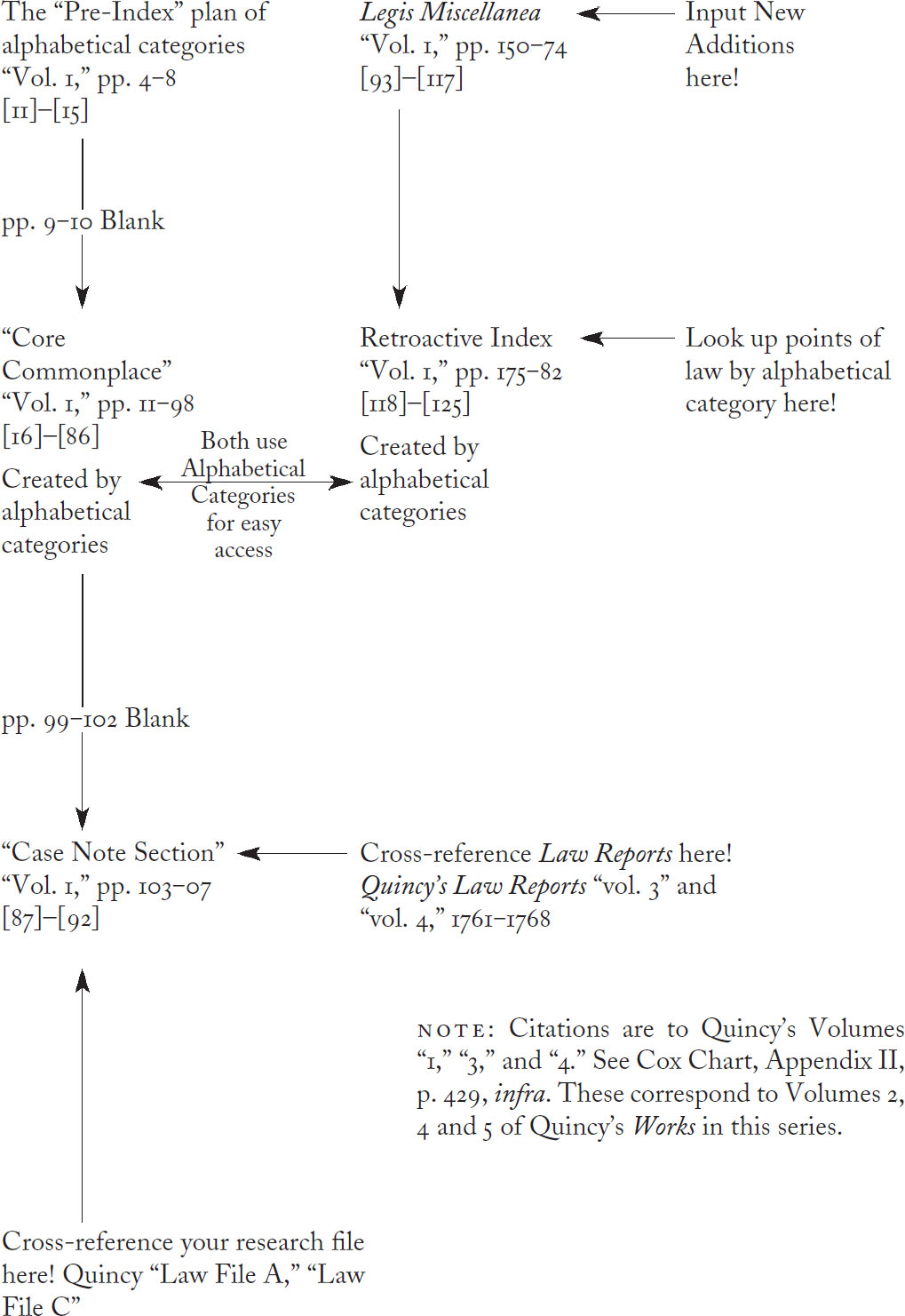
illustration 4. Sir Matthew Hale (1609–1676) was one of the dominant jurists of the English Restoration, serving as Chief Baron of the Exchequer (1660–1671) and Chief Justice (1671–1676). Noted for his moral character and his learning, he was the author of many books, including the famous Summary of the Pleas of the Crown (London, 1678), published in a better edition in 1736 as Historia Placitorum Coronae (London, 1736). Hale’s “Preface Directed to the Young Students of the Common Law,” which appeared at the beginning of Henry Rolle’s Un Abridgement des plusiers Cases … del Common Ley … (London, 1668), had a huge influence on legal pedagogy, and was carefully referred to by Quincy. See “Vol. 1,” p. 547, Reel 4, QP56, Quincy’s pages 122–41. See also Alan Cromartie, Sir Matthew Hale 1609–1676: Law, religion and natural philosophy (Cambridge, 1995). Courtesy Harvard Law School Library. My thanks to David Warrington.
If Quincy wished to update his “core commonplace,” he could add to the Legis Miscellanea or to the “Case Note Section.” The “Case Note Section” was cross-referenced to his Law Reports. Both the “core” commonplace and the retroactive index to the Legis Miscellanea, which was updated, were organized in alphabetical headings. And there were cross-references to his “Law file A” and “Law file C.” All he needed to do was remember the right alphabetical heading, and he could locate anything in the commonplace!
But this was not just a way of storing and cross-referencing information. It was a program to teach law. Setting up and compiling a commonplace was hard work. Updating it and cross-referencing the categories was even harder. Creating reports of argued cases and referencing those reports to the commonplace was harder still. It was a process that required “trial and error.” It taught by requiring the student to do the analysis and classification for himself. Again, this is the same way that the Socratic method and the case method taught law, by interaction between the student and the material.
We do not have to speculate on the sources of Quincy’s pedagogy, because he carefully copied them into the Law Commonplace itself. The most important was Chief Justice Mathew Hale’s (1609–1676) “Publisher’s Preface Directed to the Young Students of the Common Law” appearing at the beginning of Henry Rolle’s Un Abridgment Des Plusieurs Cases … del Common Ley … (London, 1668) (hereafter, “Hale’s Preface”). This was carefully copied by Quincy into “Vol. 1,” P 347, Reel 4, QP56, Quincy’s pages 122–41 (not transcribed in this series as not original Quincy).
We have already discussed, in Section A, supra, Hale’s influence on the structure of Quincy’s Law Commonplace. But equally important was Hale’s theory of legal education. He certainly believed that direct interaction between the student and the undigested mass of the law was necessary and desirable, and that struggle was a part of learning. According to Hale,
It is true, a student will waste much Paper this way, and possibly in two or three years will see many Errors and Impertinencies in what he hath formerly done, and much irregularity and disorder in the disposing of his matter under proper Heads. But he will have these infallible Advantages attending his course. 1. In process of time he will be more perfect and dexterous in this business. 2. Those imperfect and disordered essays will by frequent returns upon them, be intelligible, at least, to himself, and refresh his memory. 3. He will by this means keep together under apt titles whatsoever he hath read. 4. By often returning upon every title, as occasions of search or new intentions require, he will strangely revive and imprint in his memory what he hath formerly read. 5. He will be able at one view to feel the substance of whatsoever he hath read concerning any one Subject, without turning to every Book (only when he hath particular occasion of Advice, or Argument, then it will be necessary to look upon that Book at large, which he findes useful to his purpose. 6. He will be able upon any occasion suddenly to find anything he hath read, without recoursing to Tables or other Repertories, which are oftentimes short, and give a lame account of the subject sought for …44
Also important to Quincy was Chief Justice Thomas Reeve’s (1672/73–1737) “Directions [to his Nephews] for beginning the study of Law,” which Quincy copied into the beginning of his Law Commonplace on unnumbered pages (transcription pages [7]–[9]) (hereafter, “Reeve’s Directions to his Nephew”). See “Vol. 1,” P347, Reel 4, QP56, unnumbered Quincy introduction. Reeve emphasized the effort of commonplacing, using Thomas Wood’s An Institute of the Laws of England; or Laws of England in their natural order according to Common use (1st ed., London, 1720) (hereafter, “Wood’s Institute of the Laws of England”) “to understand the several Divisions of the Law, + obtain the precise Ideas used in it.”45 Reeve went on:
My whole scheme without naming Books, is no more than this. 1.st Obtain precise ideas of the Terms + several meanings of the Law. 2.dly Learn the general Reasons whereon the Law is founded. 3.dly Find some authentic system, collect the great heading Points of the Laws, in their natural order, as the first Heads + Divisions of your future enquiry; 4.thly Collect the several particular Points + arrange them under their generals, as they occur + as you find you can best digest them.
And whereas Law must be consider’d in a two-fold Respect. 1.st As a Rule of Action. 2.dly As the art of procuring redress when this Rule is violated; the study in each of them may be regulated by the foregoing method. And the Books so recommended will so carry on your Joint Work, that with this course so finish’d, the student may pursue each Branch of either, to its uttermost Extent, or return to his Center of Knowledge without confusion, which is the only way of rendering Things easily to the memory.46
Interestingly enough, Hale’s Advice to a Student and Reeve’s Direction to his Nephew were two of the sources recommended by Jeremiah Gridley to John Adams in 1758, five years before, along with Dr. Dickins’s “Method of Studying the Civil Law,” which we will discuss later in connection with Quincy’s collection of Latin maxims.47 John Adams also met in 1758 with Oxenbridge Thacher, who, as noted above, would become Quincy’s pupil master. Thacher also emphasized commonplacing, stating that he was “sorry that he neglected to keep a Common Place Book when he began to study Law, and he is half a mind to begin now.”48
This was no casual, haphazard course of study. The university lectures of Blackstone, to be followed by Wilson, Kent, and many others, doubtless were an easier path to legal theory. Tapping Reeve’s lectures at Litchfield and Story’s “text-and-recitation” system at Harvard may have been better structured professional training, but commonplacing had its own virtues as a way to learn. You had to discover the structure of the law for yourself. It was analogous to the “rite of passage” of having to study Coke on Littleton, remarked on by both Adams and Story, who “wept bitterly.”49 It is also comparable to the student effort required by Langdell’s casebooks and the Socratic method.50 “No gain without pain” was the informal creed of Langdell and his disciple, James Barr Ames, who rejected the predigested pedagogy of the lecture and the Continental treatise. Commonplacing was an antecedent of the agonies of the case method, and it had similar virtues.
These virtues were appreciated by those that suffered through the commonplacing process, even as they developed easier, if not better, methods. Take Joseph Story as an example. Story’s “text-and-recitation” system, coupled with his own treatises, certainly rescued the Harvard Law School from near disaster in 1829.51 His vision of a university professional school has now become the model of modern legal education.52 But he certainly appreciated the value of what Quincy was doing in the Law Commonplace. According to Story:
The early professors of the common law were compelled to resort to commonplace books, and personal reports of cases, falling under their own observation. Many manuscripts of this description are still extant, exhibiting a patient industry, care, and accuracy, worthy of all praise. The labor, indeed, of these venerable jurists almost transcends the belief of students of the present day. They noted every case, in all its points and principles. They abstracted from records, and general treatises, and private manuscripts, often obscure and crabbed, everything, that could be found to aid them in study, or in practice. They gathered voluminous collections of special pleadings, and unusual writs and judgments, to suit the exigencies of their possible avocations; and thought no labor too great, which brought any solid addition to their knowledge, or any increased facilities to their clients.53
This appreciation reflected Story’s own training. Story’s pupil master was Samuel Sewall. Sewall rejected the “catch as catch can” apprenticeship, “mechanically obtained,” in favor of examining “the theory and General doctrines and the origins of the Municipal Law [i.e., national law], and descending from generals to particulars, to discover afterwards the partial applications and limits of the system.”54 For structure, Sewall could offer Story something Quincy never had, Blackstone’s Commentaries. As R. Kent Newmyer has observed, Blackstone was “the primer,” and Story found it easy and “most elegant.”55 But Sewall soon directed Story to harder stuff: Coke on Littleton and the other classic English treatises. In Story’s words, these were filled with “dry and technical principles, the dark and mysterious elements of the feudal system, the subtle refinements and intricacies of the middle ages of the common law …”56
In addition, Sewall required Story to go beyond the treatises, and to read the American reports (there were but a few, and none published for Massachusetts in 1801) as well as many of the same English reports that Quincy digested, including the 13 volumes of Coke’s Reports (published in installments between 1600 and 1659), Plowden’s Commentaries or Reports (published in Law French in 1571 and translated in 1761) and Saunder’s Reports (published in Law French in 1686 and translated in 1722). By his own account, Story plunged into these reports and many others, reading them in conjunction with treatises like Hawkins’s Pleas of the Crown (1716–1721), all at Sewall’s direction.57 As Story’s biographer, Newmyer, has acutely observed, this was a process of integration of knowledge into a structure. Blackstone helped. “[I]t would give Story, as it gave others, the tools of legal language, a compendium of guiding principles, an introduction to English legal history, and a vision of law as a science—that is to say, as a system of interrelated principles and rules.”58 But it was just the beginning. The law reports, current American practices, and the technicalities of common law pleading had to be mastered too.
The vehicle Story used for the integration was commonplacing. As Newmyer observed, “The working lawyer’s key to survival, if not success was his form or commonplace book…. wherein practicing lawyers mobilized English precedent under the main header of law with a running count of leading American cases …”59 Story’s commonplace was prepared at Sewall’s direction but, it appears, despite Sewall’s promises to “assist you in arranging your learning,” it was Story’s own work. Story saw this effort and struggle as essential to mastering law. “I felt that I breathed a purer air … and that I had acquired a new power.”60
Story’s law training was the training of a future Justice of the United States Supreme Court and the savior of Harvard Law School. Note how close it was to that of Quincy! Although Story’s apprenticeship ended in 1801, more than thirty-five years after Quincy’s Law Commonplace, the basic ingredients were the same. Of course, Story had Blackstone. Initially, lacking Blackstone, Quincy had to turn to Matthew Hale’s Introduction to Rolle’s Abridgment (1668), Thomas Wood’s An Institute of the Laws of England (1720), and Charles Viner’s General Abridgment of the Law and Equity (23 vols., 1741–1753) for structured categories. In addition, by 1801 Story had a few American reports to integrate with the English reporters. Quincy had to create his own. But the process, and the struggle, was the same. At its best, it was a pedagogy that created good, even great, lawyers. As Newmyer observed:
If a good education is one that equips its recipient to do what has to be done, Story’s law-office education was an excellent one. He learned the theory and was at home in the practical application of it. He was ready to do business. But he learned more, too. The three years of apprenticeship had left him with a deep love of the law and a lasting admiration of legal science.61
The same was true of Quincy. How many of our law students could say the same today?
There remains one final pedagogical aspect of the Law Commonplace. To modern legal educators it seems particularly alien and strange: learning by maxims. Quincy sprinkled Latin maxims throughout the Law Commonplace. Many were extracted from Coke on Littleton or from Justinian’s Institutes and the Digest. In addition, in both “Vol. 3” and “Vol. 4” of his notebooks, he set out a collection of two hundred and twelve Latin maxims grouped together, at (“Vol. 3”) P 347, Reel 4, QP57, pp. 161–63, 171–83, and (“Vol. 4”) P347, Reel 4, QP58, pp. 151–56. Forty-four of these are almost entirely from Roman law sources, particularly the Digest, Title Fifty, Section XVII, De Diversis Regulis Juris Antiqui. The rest are from common law authorities, particularly Coke’s Reports and Institutes. Thanks to the tireless work of two of my former research assistants, Susannah B. Tobin, Harvard Law School, Class of 2004, who continued her efforts long after graduation, and Elizabeth Papp Kamali, Harvard Law School, Class of 2007, these collected maxims have been brilliantly transcribed and translated as Appendix I, Quincy’s Latin Maxims, at the end of the Law Commonplace.
Perhaps Quincy’s extensive study of Latin maxims should not be surprising. He and his peers were fluent in Latin. Both John Adams and Joseph Story integrated the study of civil and Roman law into their original legal studies.62 Adams had served an apprenticeship with John Putnam of Worcester between 1756 and 1758, which did not always go smoothly. When he arrived in Boston in 1758, he sought the support of Jeremiah Gridley, then the informal dean of the Boston bar. Adams recounted the meeting:
Then Mr. Gridley inquired what Method of Study I had pursued, what Latin Books I read, what Greek, what French. What I had read upon Rhetorick. Then he took his Common Place Book and gave me Ld. Hales Advice to a Student of the Common Law, and when I had read that, he gave me Ld. [Chief] [Justice] Reeves Advice [to] his Nephew, in the Study of Common Law. Then He gave me a Letter from Dr. Dickins, Regius Professor of Law at the University of Cambridge, to him, pointing out a Method of Studying the civil Law. Then he turned to a Letter He wrote himself to judge Light-foot, Judge of the Admiralty in Rhode Island, directing to a Method of Studying the Admiralty Law. Then Mr. Gridley run a Comparison between the Business and studies of a Lawyer or Gentleman of the Bar, in England, and that of one here. A Lawyer in this Country must study common Law and civil Law, and natural Law, and Admiralty Law, and must do the duty of a Counsellor, a Lawyer, an Attorney, a solicitor, and even of a scrivener, so that the Difficulties of the Profession are much great here than in England. The Difficulties that attend the study may discourage some, but they never discouraged me.63
Adams took the advice on Roman and civil law study seriously. “I have read no small Number of Volumes, upon the Law, the last 2 Years [1758–1760]. Justinian Institutes I have read, thro, in Latin with Vinnius’s perpetual Notes, Van Muydens Tractatio Institutionum Justiniani, I read thro, and translated, mostly into English, from the same Language. Woods Institute of Civil Law, I read thro. These on the civil Law …”64
As we have seen, five years later, Quincy set out on an almost identical path. Copied into the same volume as Quincy’s Law Commonplace are the two suggested courses of study Gridley gave to Adams, Matthew Hale’s Advice to a Student (1668) and Lord Chief Justice Reeve’s Advice to His Nephew in the Study of the Common Law (1736?). See (“Vol. 1”) P347, Reel 4, QP56, Quincy, pp. 122–41 and unnumbered Quincy pages at commencement, pp. [7]–[10], respectively. But there is something even more remarkable. Dr. Dickins’s Method of Studying the Civil Law, as recommended to Adams, was also copied into “Vol. 4” of Quincy’s notebooks, although not in Quincy’s hand. See (“Vol. 4”) P347, Reel 4, QP58, pp. 148–50. This is the same volume that contains some of Quincy’s Latin Maxims.65
Of course, studying maxims was not necessarily about Roman and civil law. Throughout the sixteenth, seventeenth and eighteenth centuries, Latin maxims were seen as a major aid to both memory and legal analysis of the English common law. The leading influence was Francis Bacon’s A Collection of Some Principal Rules and Maxims of the Common Lawes written between 1596 and 1597 and first published posthumously in 1631, but there were many more common law “maxim” books, designed for students and practitioners alike.66 Of particular importance was John Dodderidge’s (1555–1628) The Lawyer’s Light, which was also published posthumously in 1629 from a manuscript entitled Methodus Studendi. Dodderidge divided his book between “primary principles,” which he called “maxims,” and “secondary principles,” which he called “rules.” “‘Rules’ differed from ‘maxims’ in that they are ‘not so well known by the light of nature … and are peculiarly known for the most part, to such only as profess the study and the speculation of the law.’”67 Bacon also distinguished between “legum leges,” “law of laws,” and “ordinary and vulgar” maxims.
And therefore, whereas these rules are some of them ordinary and vulgar, that now serve but for grounds and plain songs to the more shallow and impertinent sort of arguments; other of them are gathered and extracted out of the harmony and congruity of cases, and are such as the wisest and deepest sort of lawyer have in judgment and use, though they be not able many times to express and set them down: for the former sort, (which a man that should write rather to raise a high opinion of himself than to instruct others would have omitted, as trite and within every man’s compass,) yet nevertheless I have not affected to neglect them; but having chosen out of them such as I thought good, I have reduced them to a true application, limiting and defining their bounds, that they may not be run upon at large, but restrained to point of difference.68
Thus, the collection and the study of maxims can be used to structure legal principles, as well as to aid memory.
Bacon saw this use of maxims as a way to improve commonplacing. “For as, both in the law and other sciences, the handling of questions by commonplace, without aim or application, is the weakest so yet nevertheless many common principles and generalities are not to be contemned, if they be well derived and deduced into particulars, and their limits and exclusions duly assigned.”69 In addition, whether the source of a maxim be from the Roman law or the common law, the inherent reason of the maxim was seen by Bacon as a source of authority in legal argument, quite apart from case precedent. Thus, while Bacon claimed his maxims were all derived from legal authorities, and “in mine own copy I had them quoted,” he deliberately omitted the citations and let the maxims stand on their own!
[T]he reason is, because I judged it a matter undue and preposterous to prove rules and maxims…. Well will it appear to those that are learned in the laws, that many of the cases are judged cases, either within the books or of fresh report, and most of them fortified by judged cases and similitude of reason; though, in some few cases, I did intend expressly to weigh down the authorities by evidence of reason, and therein rather to correct the law, than either to soothe a received error, or by unprofitable subtlety, which corrupteth the sense of the law, to reconcile contrarities.70
This view of the inherent “authority” of maxims was not limited to Bacon or the seventeenth century. In a number of important cases in Quincy’s Reports, leading advocates such as Gridley or James Otis Jr. used “naked” maxims in the abstract as part of their argument. For example, in his historic appearance before the Governor and Council in 1765, in the Memorial of Boston, Jeremiah Gridley argued that the Stamp Act contravened basic human reason. There could be no legal proceedings without the stamps, but the stamps “were not to be obtained.” “That the Law never requires Impossibilities Is a Maxim of the Law.”71 No other authority was given!
Where Roman maxims also supported a common law principle, the “antiquity” and “universality” made it particularly compelling. Thus, in the same historic Memorial of Boston in 1765, John Adams argued “That the Subject is not bound by Acts, when he is not represented, is a sound Maxim of the Law, and not peculiar to the British Constitution, but a Maxim of the antient Roman Law: ‘What concerns All shall be judged of by All.’”72 This special authority of concurrent Roman and common law maxims was also argued by Bacon.
[W]hereas some of these rules have a concurrence with the civil Roman law, and some others a diversity, and many times an opposition; such grounds as are common to our law and theirs I have not affected to disguise into other words than the civilians use, to the end they might seem invented by me, and not borrowed or translated from them: no, but I took hold of it as matter of great authority and majesty, to see and consider the concordance between the laws penned and as it were dictated verbatim by the same reason.73
Thus, Quincy’s list of 44 Latin maxims from the Digest’s De Diversis Regulis Juris Antiqui (Title 50, Section 17), and other civil law sources, was not just an antiquarian exercise. Rather, it served three important functions: as a way to classify and learn legal principles, a form of comparative law study, and an independent source of authority.74 This was a legal system lacking all native law reports and facing a high rate of change. Appeal to the universal principles represented by maxims was not just tempting, it was necessary. James Otis, following John Adams in the Memorial of Boston–Stamp Act appearances, gave what all contemporary witnesses agreed was a great legal argument.75 At its core was an appeal to a “naked” or “self-evident” legal maxim. “It was once a fundamental Maxim, that every subject had the same Right to his Life, Liberty, Property and the Law, that the King had to his Crown …”76 Whether as an aid to memory, a structure for commonplacing, or as a source of authority in itself, the study of maxims, “aphoristic pedagogy,” was important to Quincy and his legal world.
III. THE DOCTRINES AND THE SOCIETY
Quincy’s Law Commonplace can teach us a lot about colonial legal education, but it is also a treasure house of information about what the law was, and how people lived. In a commonplace book, the last two really are inseparable. Books like Wood’s An Institute of the Laws of England (1720) or Blackstone’s Commentaries (1765–1769) could, and often did, exist in a theoretical test tube, far removed from what Langdell called “the ever-tangled skein of human affairs.”77 But the purpose of commonplacing was to apply doctrine to that “ever-tangled skein,” in actual practice. Again, as discussed in Section A, supra, Quincy’s Law Commonplace was not a defined, closed, formal, system of learning, but was designed to be constantly updated through the Legis Miscellanea sections, as Quincy gained experience.78
Both the initial “index” of Quincy’s Law Commonplace and the retroactive index of the Legis Miscellanea indicate what was considered important in practice. But this is particularly true of the Legis Miscellanea index, because it shows what was “added” on as Quincy studied and observed his pupil master and court cases. The former index is like the “suggested curriculum” of today’s law schools. The Legis Miscellanea is more like the little notebook I kept when I first practiced law. It did not reflect what my law teachers thought was important, but rather what I learned in the “school of hard knocks,” day by day, at my Boston law firm. A lot of my notebook was about my clients and their needs, rather than just legal rules and doctrines, and that is certainly true of Quincy’s Law Commonplace. This is where society meets doctrine.
Here is an example from the “Case Note Section” of the Law Commonplace, also cross-referenced to Quincy’s “Law file C.”
W[h]ether, a negro woman being with child complains to a Just Pacis [Justice of the Peace] of a free White Man being the father, can the Justice upon such Complt [Complaint] issue his Warrant agt the Man + recognize him to appear before the Sessions as provided by the Prov. Law p. 10. 11 in Case of a White Woman gotten with Child. This Question answer’d in the Negative. + the reasons Why. vid.
Law-file C. Law Commonplace, p. 106 [91].
Colonial welfare law depended on taking responsibility for your children, and justices of the peace had a general power to issue warrants to question witnesses. See Province Laws (Geo. II anno. 17, 1744) Chap. 222, The Charters and General Laws of the Colony … of Massachusetts Bay (Boston, 1814), pp. 551–52 (hereafter, “General Laws”). See also Colony Laws (1642, 1665) Sections 1–3, and the discussion at page [92], note 6. See also Douglas Lamar Jones, “The Transformation of the Law of Poverty in Eighteenth-Century Massachusetts,” Law in Colonial Massachusetts (D. R. Coquillette, R. J. Brink, C. S. Menard, eds., Boston, 1984), pp. 153–90. (Hereafter, “Jones, Law of Poverty.”) At almost exactly the time Quincy made this notation, there was a well-documented case in 1765 of an Amos Jewett Jr. being found liable for five shillings per week to support two bastard children, twin boys, by one Sarah Moor of Rowley. Id., p. 162, see Rowley Sarah Moor, File Papers, 1767, Essex Sessions. In 1767, Jewett was sent to debtors’ prison because he could not keep up the payments. This was a serious concern to the selectmen of Rowley, who would otherwise have to “absorb the costs of raising Sarah’s children.” Id., p. 163.
So the usual legal doctrine was one of responsibility, backed by a powerful social policy of enforcement, to keep the cost from falling on the relevant town or city. Justices of the peace had statutory power to hear such complaints and subpoena witnesses. Why not here?
Quite obviously, Quincy’s notation tells us as much about race and gender politics in 1763 as it tells us about a rule of law. We would like to see “the reason why” in Quincy’s last “Law file C,” but it is quite clear that accusations by a black woman against a white man would not be allowed, despite strong policy reasons to establish paternity. Perhaps the relevant town could bring the complaint instead, but this case is more than a legal doctrine, it is a window into colonial racial politics.
There are many such windows in the Law Commonplace. Here are just a few examples, taken from three of Quincy’s most “active” alphabetical categories, “Baron + Feme” (husband and wife), “Apprentices and Servants,” and “Jury.” Each of these categories contains a number of legal rules and doctrines, but also graphically illustrates the “real world” of colonial society in which these laws existed and operated.
In Quincy’s Massachusetts social reality and legal doctrine were closely linked. This was because of the state of the legal system and public attitudes toward legal authority. These attitudes can be particularly well understood by studying the Law Commonplace together with Quincy’s manuscript Law Reports, against which the Law Commonplace was cross-referenced. Most colonial judges were laymen, who rarely gave reasons for their decisions. In addition, these decisions, as in England, were usually given orally from the bench. Quincy’s Reports, therefore, consist mainly of reciting the facts of the case, the arguments of counsel, and the base vote of the judges at the end—although the judges often asked questions and made remarks that reveal the reasons for their vote.79 Many of these cases demonstrated a strong social pragmatism, in both the rationales of the arguments and the judicial comments.
This pragmatism was supported by ambiguity as to the source of law and legal authority. Massachusetts was subject to what my colleague Mary Sarah Bilder calls “the transatlantic constitution.”80 Under the charter of 1691, the colony could make laws “not repugnant or contrary to the laws of this our realm of England.”81 There was also a strictly limited appeal to the Privy Council in London in civil actions “wherein the matter in difference doth exceed the value of three hundred pounds.”82 This was a large sum of money, and, in practice, leave to appeal was granted with great reluctance.83
There were no published colonial law reports. Colonial statutes often did not pertain to key areas of legal dispute and, even then, could be ambiguous and badly drafted. Thus, the courts had quite a bit of discretion. The real issue was how closely they were required to follow English common law doctrines, as set out in the English texts and reports available in the colony. After Coke’s famous decision in Calvin’s Case (1608), it was clear that English law “was not automatically received in conquered territories” and, thus, arguably not in the American colonies.84 In addition, English authorities were often not cited in oral argument, particularly in less lucrative cases. In these “lesser” cases, the lawyers often took little time to prepare their legal authorities, sometimes to the annoyance of the judges—and Quincy.85 When English precedents were relied on, as in the major inheritance cases, they were often invoked by both sides, with a cavalier disregard for what the cases actually said, again to Quincy’s expressed irritation.86 Even in major cases, the final decision could depart markedly from English legal doctrine. The justification given was sometimes local customs, or practical necessity, or social policy, or all three. As we will see in the Introduction to Quincy’s Reports, Quincy Papers, Volume 4, sometimes the judges gave no reasons at all, even for important departures. The inherent assumption, infrequently voiced explicitly, was that such departures did not violate the “repugnance” provision of the Charter, an easy argument to make if the English Common law was uncertain or, as was often the case, poorly researched. Appeals to the privy council were extremely scarce in Quincy’s Reports, and were clearly looked on with disfavor.87 Practical, social policy arguments, made in argument by counsel, were sometimes reinforced by ad hoc judicial comments, picked up by Quincy, and often seen to explain the decision itself.88
Scholars like Morton Horwitz have argued that “[t]he generation of Americans who made the American Revolution had little difficulty in conceiving of the common law as a known and determinate body of legal doctrine,” quoting Chief Justice Hutchinson’s remark, recorded by Quincy in 1767, that “laws should be established, else Judges and Juries must go according to their Reason, that is, their Will.” Reports, pp. 234–35, “Charge to the Grand Jury,” 1767.89 Quincy himself, in his Southern Journal, criticizes the South Carolina bar for ignorance of the law, pointing out that it meant that the courts were free to do whatever they wanted.90 But the remarks of Hutchinson and Quincy cut both ways. Hutchinson was increasingly frustrated that juries, particularly the grand juries he charged, simply ignored what he regarded as “the law,” and Quincy pointed out the indifference of practicing lawyers and judges, in both the North and South, to common law doctrine, and the total ignorance in South Carolina of the common law forms of action.91 In this void, both lay judges, jurors and practitioners could be pragmatic and policy oriented. Indeed, they had little choice. Blackstone’s conception of a rigid judicial adherence to precedent and a clear distinction between legislation and judicial decisions required not only a “knowable” and determinate body of common law, but lawyers and judges that knew it.
As both his Law Commonplace and Reports demonstrated, Quincy wanted to know the law, and he knew a lot of it. The start of the Law Commonplace in 1763 predated the appearance of Blackstone’s first volume of his Commentaries in 1765. There is but one citation to Blackstone’s Commentaries, to the 1765 first volume, and only an occasional reference to Blackstone’s Analysis of the Law (1756).92 Quincy’s conception of the role of common law decisions, the jury, and statutes can neither be blamed on ignorance of the law nor on Blackstone. Thus Quincy makes a particularly interesting test case for our theories about colonial jurisprudence.
It is Horwitz’s famous thesis that between “[t]he generations of Americans who made the American Revolution” and the world of the new Republic of 1820, a major change occurred, a “transformation of American law.”93
By 1820 the legal landscape in America bore only the faintest resemblance to what existed forty years earlier. While the words were often the same, the structure of thought had dramatically changed and with it the theory of law. Law was no longer conceived of as an eternal set of principles expressed in custom and derived from natural law. Nor was it regarded primarily as a body of rules designed to achieve justice only in the individual case. Instead, judges came to think of the common law as equally responsible with legislation for governing society and promoting socially desirable conduct.94
This “transformation,” in Horwitz’s view, was symbolized by a shift from a “Blackstonian” conception of the law, with a strict adherence to common law precedent by judges and a clear distinction between the role of a statute and a judicial decision, to something altogether different, where instrumental judicial legislation was candidly recognized.95
The Law Commonplace can hardly be an adequate test of this major theory. Quincy was just one colonial lawyer, and an atypical one at that—particularly bright, rich, and well-educated. But he was very interested in the things that constitute the core of Horwitz’s theory, such as the nature and source of common law precedent, the role of jury in “achieving justice … in the individual case” and the function of statutes. The resulting record describes a legal world which, while mindful of doctrine, was remarkably pragmatic and sensitive to understanding economic and social needs. Let us look at some examples from the Law Commonplace.
A. Doctrines of Gender
As my distinguished colleague, Mary Sarah Bilder, observed: “The laws of England preferred inheritance practices that were gendered (favoring the eldest son), lineal (favoring keeping land within bloodlines), and ancestral (favoring inherited land).”96 Thus the “pigeon holes” for gender in Quincy’s Law Commonplace include “Estates, and Lands, Tenements and Hereditaments”97 as well as the more obvious “Baron + Feme”98 [husband and wife] and “Marriage.”99 Also included should be “Powers,”100 which include the critical issues of what a married woman can do legally, and “Base Possession,”101 which include issues of whether a wife’s mere possession of goods or property is imputed to the husband.
Massachusetts had early rejected the English doctrine of “primogeniture,” that intestate land descends solely to the eldest son.102 The “repugnancy” to English law clause of the 1689 Charter was carefully circumvented.103 “Part-ibility” [i.e., equal division to each child] or “coparcenage,” the usual English doctrine when a testator had only daughters, was imposed by statute.104 The major issues arose when the “partibility” doctrine was circumvented by will, usually by attempting an “entail male,” i.e., descent by male blood heir only, or reversion to testator’s direct heirs.105 The Superior Court of Judicature felt constrained to accept such gendered restrictions, but only if the will was legally correct. Ambiguities were resolved for partibility, a distinct difference from English law.106
Quincy’s Law Commonplace emphasized two important distinctions. Land brought into a marriage by the wife may be in control of the husband during the wife’s life, but on her death is certainly treated differently from lands brought to the marriage by the husband. “But where lands do descend from the part of the mother, the Heirs on the part of the father never inherit so on the contrary. Observe then the difference where the son purchaseth lands in Fee-s[imple] + where he comes by them by descent, on the part of the mother, or of the father.”107 In addition, bias against female gender was trumped by the bias toward blood lines. “A sister of the whole blood shall be preferred before the younger of Brother of the Half Blood.”108 Absent, however, from the Law Commonplace were the struggles over male entail so carefully chronicled in Quincy’s Reports.109
More prominent in the Law Commonplace was the legal subordination of a married woman. In fact, “Baron & Feme” (“Husband and Wife”) constitutes the largest section of the “core” commonplace, not counting related sections, like “Marriage” in the Legis Miscellanea.110 Quincy’s world was one of social, racial and gender hierarchies, and it is not surprising that a law student would organize the law in this way. Indeed, modern critical jurists and legal realists would see such a structure as more “honest” or natural than the doctrinal formalism of Langdell and the “categories” of legal education that have persisted to this day.111
In theory, the marital subordination of women “cut both ways”; married women had clear privileges and rights based on their status, as did married men. Sometimes the disabilities were mutual. Evidentiary privilege is one example of a mutual disability, duly noted by Quincy. “Baron + feme cannot be witnesses for or ag.t each other,” with the exception of high treason and “3 H.7 Chap.2”112 The latter statutory exception was also carefully noted by Quincy, “where the wife may be evidence against her husband forcibly taking her away and marrying her,” tracking the 1488 statute of Henry VII which established penalties for “carrying a woman against her will, that hath lands or goods.”113 Thus while evidentiary disabilities were, in theory, mutual, the “force” exception shows that in practice they might particularly harm women. In any event, if so much depended legally on marriage, a forced marriage was reprehensible.
Again, in theory, the feme “covert,” the married woman, could not contract, could not appear in court, and could not have “seisin” of land except through her husband. “The wife is so much under the power of her husband, that she is disabled to contract with any person without his consent …”114 But Quincy added some key, underscored words, “without his consent, precedent or subsequent, express or pre-sum’d.”115 Here we have another window into the reality of the colonial world. Despite his English sources, Quincy observed:
She [the married woman] cannot bind her H [husband] in Strictness for Necessaries by any contract, unless a precedent or Subsequent assent is proved or presumed; But usually her Contracts are allowed, if She buys goods for herself, Children, or family, as Bread etc. or for her own necessary Apparel. The H is bound to maintain his W [wife] in Necessaries, + therefore if Goods come to H’s Use it is Evid. to prove his Assent, but not binding Evid; for it may be contradicted by Other Proof as that He gave his Wife ready money; Admitting then that the H sh.d be charged in strictness for necessaries; tho’ he knows nothing of them; [yet if]1 he forbids particular Persons to trust his W, he shall not [be] charged after such Prohibition.116
So, as a practical matter, a colonial wife could engage in normal shopping, and trades-people could enter into normal supply contracts with her, unless they had actual notice that there was no normally “pre-sum’d” consent from the husband. Even general notice was not enough, according to Quincy. “A prohibition in general not to trust a wife, as by putting her in the gazette, etc. cannot amount to legal notice.”117
The problem came when the wife engaged in a trade or business outside of household “necessities.” There is evidence in both Quincy’s Reports and the Law Commonplace that this certainly occurred. Such activities ranged from criminal activity, such as acting as a “fence” for stolen goods or running a “bawdy house,” to the practice of medicine.118
A man shall not be charged by the contract of his W, (except as above for necessaries) if he hath no notice of it, tho’ the things do come to his use. Neither, shall a H be bound by his W’s receipt of his money.119
But actual practice was more complex. In his Legis Miscellanea, Quincy emphasized an English case in which a woman was practicing medicine, Brashford v. Buckingham and his wife (1601), 2 Coke’s Reports (London, 1657), p. 77.120
• Action brôt by Baron and Feme on a promise made to ye Feme in consideration, she wd cure such a wound and alleges she did cure. Adjudg’d good upon Writ of Error, in Exchequer Chamber because the Action is grounded upon a promise made to ye feme + upon a matter arising upon her Skill + a performance to be made by her Person + such an Action wd survive to the feme. Cro. James 77 This case is [discussed?] at Barnardiston 75.+ [And] debt upon judgment in Trespass for 10/ Damages + 40/ Cost, + the Statute pleaded. Vide. 2. Vent. 36.121
Quincy also emphasized another English case where a woman was “carrying a trade in her own name as a widow,” and then sought to use “coverture” to escape her obligations.
A woman whose husband has left her about 12 years before had carried on trade in her own name as widow + given receipts in her own name, being sued for debt contracted in the course of her trade gave coverture in evidence + that her H. had been lately in Ireland+ Holt directed the Jury to find for Defn + so they did. 1. Bac. 308. On N. A. Deft proved she had a H. alive in France Jury found for plf. On motion for a new trial as a verdict against evidence it was denied for a divorce shall be intended. 1. Salk. 117.122
Thus if a woman’s husband was dead, or if a divorce “shall be intended,” she would have the power to enter binding contracts, even entered into while married, as long as the people dealing with her believed they were doing business with the woman on her own account, a doctrine similar to the “sole trading” cases “according to the custom of the … City of London.”123
Quincy added a final English case relating to “separation by consent.”
If B. + Feme separate by consent + she has a separate allowance tis unreasonable she should have it in her power to charge him + it is not to be presumed but tradesmen trust her on her own credit + not the credit of her H. + a personal notice is not necessary it is sufficient that it be public + generally known. Holt ruled a H. was liable to his wifes contracts, because they cohabitated. 1. Salk. 113—Everyman is obliged to maintain his wife + an action may be maintained against him for necessities provided suitable to her rank in life124
While the selective mixture of English precedents in Quincy’s Law Commonplace can be no more than a suggestion as to the colonial law, the picture that emerges is fairly practical, given the overall gender bias of the law. In theory a married woman had no legal personality, except to protect herself from being forced into marriage itself and, in Quincy’s words, “If the husband threaten his wife to beat or to kill her, she may make him find security for the peace.”125 But in practice, the legal obligation of the husband to provide “necessaries,” including “necessities provided suitable to her rank in life,” provided implied consent to most domestic transactions, absent actual notice.126 Where the woman was doing business on her own, she could use her husband’s legal personality, where appropriate, to appear in court or enforce deals. Where death or separation made this impossible, Quincy’s precedents were sympathetic to enforcing the contracts as to the woman, so long as the other parties believed they were dealing with the woman in her own capacity or on her own credit.
The system gave the married woman three sources of security, besides simply not being beaten. We have mentioned the husband’s duty to provide “necessities … suitable to her rank in life.” The other two, which attach on the husband’s death, receive much attention in Quincy. These are the right of the woman to “dower,” a one-third life interest in her deceased husband’s estate, and, equally important, the return to her legal ownership of the real property she brought to the marriage.127 Of course, if the husband survived the wife, he had his own security in her property, “Curtesy of England,” which, assuming a child of the marriage had been born alive capable of inheriting the wife’s lands, gave the husband an estate in all of those lands for life.128 Dower was particularly important to women if efforts had been made to place lands in a male entail to the prejudice of a woman’s inheritance, a growing source of litigation in the colonies.129
Quincy’s notes also emphasized the effect of marriage on previously held debt.
DEBTS of the WIFE dum sola. [i.e., “contracted while single”] If the W before M [marriage] was in Debt, the H + W must be sued for this Debt, living the W. But if the W dies, the H shall not be charged for the debt of his W after her Death, if the Creditors of the W do not get Judgmt during the Cover-ture. The H, as such is not chargeable in a Ct of Equity, anymore than at Law, with the Debts of the W after her Decease; not even tho’ he had a large Fortune with Her; as on the Other Hand he is, during the Coverture liable to all her Debts, altho’ he did not get a shilling with her.130
Citing Thomas Wood’s An Institute of the Laws of England (London, 1700), vol. 1, c. 6, pp. 61–63, “effects and consequences of marriage.” (notes deleted).
While the husband would be fully chargeable with the wife’s debts while she was alive, he was not responsible on her death. But the biggest trap was the other way around. If a woman with “a large fortune” married an insolvent husband, all her property could be seized by his debtors, without her consent.
This appears to have been the subject of one of Quincy’s most interesting reported cases, Hanlon v. Thayer, Case 37, (1764), Reports, p. 99 (the so-called “naked wife” case).131 Mrs. Mary Hanlon brought suit in trover132 through her husband, Mark, to recover “Apparell” attached by her husband’s creditors, altogether twenty-one entries of clothing and household goods.133 Mary Hanlon was a widow of a fairly wealthy merchant, John Salmon, and Mark was her second husband, “a mariner and a Yoeman.”134 The first issue in the case was whether it made any difference whether the clothes were brought into the marriage by Mary. On this, the court had little trouble. Justices John Cushing and Peter Oliver observed that, although “the Case was very hard upon the Wife, who brought all these Cloaths at Marriage, yet ‘as they are personal Property, they become the Husband’s on Marriage, and therefore liable.’”135 The more interesting issue was whether there was an exception for “necessary” clothes. There were two separate grounds for this exception: (1) the “necessities … suitable to her rank in life” exception to the ban on contractual powers and (2) the “necessary bedding utensils and implement of the household necessary for the upholding of life, to the use of the wife and family of the deceased” exception to the assets of an insolvent estate established by the 1710 Provincial Statute.136 See Charters and General Laws, supra, Chap. 100 (Ann. 9, 1710), Sect. 2, p. 390.
Chief Justice Hutchinson observed that this was a “Matter of great Consequence,” and scolded the bar for failing to argue “more largely” with “more Authorities cited.”137 He continued:
I always took it to have been the Custom in such Cases as this, for the Wife to have her Cloaths; in Cases that have come before me as Judge of Probate I never knew it denied to the Wife where the Estate was insolvent. In the Case cited [by Mr. Gridley] I suppose the Woman was a Party, and the Debt contracted by her; this alters the Case much, but yet I apprehend (here Ch. Just. Makes an Apology for what follows) that this may be one of those Cases where the Justice says a Thing obiter, or suddenly; for one Gown can never be supposed sufficient—must she go naked when that is washing? Upon the Whole I think it would be very hard upon the Wife, should such a Precedent as this take Place, that her Cloaths which she brought in Marriage must go to discharge the Husband’s Debts. I should think it safer to verge towards Conveniency than to strain the Word Necessary.138
It remains unclear from the report if the other justices agreed, but Quincy noted that “the Jury found for the Defendant Costs.”139
Despite the hazards of marriage to a woman’s legal powers, it could be more dangerous to be unmarried. In at least two Quincy cases women desperately sought to prove their marriages. In the first, the defendant’s life depended on it, as she was charged with the murder of a bastard child. Quincy began the report of Dom. Rex v. Mangent with the caption “Life and Death.”140 Under a 1696 Provincial Statute, the unmarried mother of a stillborn child without a witness was presumed a murderer.141 Fortunately, it was decided that her marriage certificate from a minister “in another Government … without any authentication from any Magistrate” was acceptable.142 In the leading entail case of Banister v. Henderson, also reported by Quincy, the widow’s children were hard pressed to prove marriage in the absence of a certificate of marriage, despite the fact that their mother and father had lived together for many years as a married couple “both in Old and New England.”143 Once again the Chief Justice scolded the bar “for Want of Authorities,”144 and found for himself a passage in Thomas Wood’s A New Institute of the … Civil Law (first published, London, 1704) that “half Proof, ought to be extended in Favour of Marriage, rather than contrary to it.”145
Quincy’s Law Commonplace contained many more examples of “baron and feme” legal power issues, particularly in his “add on” Section, “Legis Miscellanea Cursim,” indicating that these were common issues observed in practice and in his assigned legal reading.146 Strangely lacking from the Law Commonplace, however, is any extensive discussion of the most pressing gender issue outside of marriage, male entails. As emphasized before, a string of important cases in Quincy’s Reports show that the colonial bench and bar were deeply divided as to whether to encourage a construction of ambiguous or poorly drafted wills to lock land up in an eldest male only line, or to encourage “partiblility” among male and female heirs equally.147 Except for a cursory mention of testator intent in the Legis Miscellanea, however, these issues were simply not dealt with by the Law Commonplace, emphasizing the importance of the later Reports as a valuable, and often more sophisticated, complement to the earlier Commonplace.148
B. Doctrines of Servitude
In addition to married women, Quincy’s Law Commonplace contains many other sections describing the legal rights of different types of people. Some such categories are still familiar to us today, and Quincy’s notations in the Legis Miscellanea index covering “Infants, Ideots, + Madmen, etc.” seem familiar.149 Slavery was omitted from the Law Commonplace altogether. Quincy’s Reports contain cases that make it clear that slaves had no legal personality in Quincy’s Massachusetts, and were regarded as chattel.150 They were not just people with diminished legal rights—they were simply not considered people at all. As discussed before, Quincy did note the different treatment of whites and free blacks, whose civil rights were curtailed by numerous provincial statutes.151 Also, “in the middle” were indentured “apprentices and servants.”
The importance of the “apprentice and servant” class to Quincy’s legal world was emphasized by long sections in the “core” Commonplace and by an important 1763 case in the Reports, Dunten v. Richards.152 Like marriage, apprenticeship was a two-way street, based on a legal undertaking whose terms were often implied by law. Thus “[i]t is a reasonable cause of Departure from service if the servant is not allowed sufficient meat, Drink, etc. or if the master’s wife beats him.”153 Also like marriage, the apprentice lost much of his or her legal personality. As Quincy noted, summarizing two English cases:
A waterman’s widow took an Apprentice, who went to sea (being pressed into ye Queen’s service) + earned 2 tickets [entitlements to accrued pay], wch came to ye dft’s hands [probably a money lender]. She bro’t trover for ye tickets, + had judgment; for what ever an apprentice gains belongs to his master, She may action for it. 1 Salk 68. Barber v. Dennis.4 And if he be an appren[tice] only de facto it is sufficient. 6 Mod. 64. cited 3 Vin: 23. notes q: v.5154
But, like the wife, the apprentice had rights to “necessities” and could not simply be “dumped.” This was true of long term “servants” as well. “If a servant retain’d for a year falls sick, etc. the Master cannot put away his servant, or abate his wages.”155 And, to some extent, the master took over the servant’s legal personality as well, particularly when that servant was acting on the master’s business. “If any servant is cozen’d of any money. I may have an action against the Person that cozen’d him.”156
When doctrines of servitude and doctrines of marriage collided, it could get complex. For example, if an apprentice married without the master’s consent, “the master cannot turn him away for that reason,” but the master could sue in covenant if the marriage violated the explicit apprenticeship agreement.157 What if a woman servant married and became a feme covert, can her husband break her servitude? Or, suppose she becomes pregnant, in or out of marriage? Quincy noted the following answers:
If a Woman that is a Servant doth marry, yet she must serve out her Time, + her Husband cannot take Her out of her Master’s service. And if a Woman, being with Child of a Bastard, procures Herself to be retain’d with a Master, who knoweth nothing therof, or if She begotten with Child during her Service, this is a reasonable Cause why the Justices shd. dicharge her from her Service, for She hath made herself incapable to serve any longer.158
Apprenticeship was a special type of servitude because it was always based on a writing, and had to be terminated by a writing and a magistrate. Quincy paraphrased the section of Dalton’s Countrey Justice (London, 1618, many editions before 1746).
An apprentice cannot be sent out of England, unless the Nature of his Service does require it. As an apprentice cannot be made without Writing, so He cannot be discharg’d by his Master without Writing under his Hand, + with the Allowance of One Justice.159
In addition, an apprenticeship did not terminate on a master’s death, but became part of the assets of the estate, just like a slave.
If any Master dies, the apprentice goes to the Exttor or admttnor, to be maintained, if their be assets. But the Exttor he may bind Him over to Another Master for the remaining Part of his Time. Wood. B.1.c6. p 52.160
[Thomas Wood, An Institute of the Laws of England (London, 1700), vol. 1, c.c., p. 52.]
Henry Sumner Maine famously described the progress of modern law as from “status” (i.e., “where old law fixed a man’s social position irreversibly at his birth”) to “contract” (i.e., where “modern law allows him to create it for himself”).161 What Quincy would have thought of Maine’s ideas remains uncertain. Despite obvious unfairness and adhesion, he would probably have regarded the apprenticeships and servitudes of his day as free contracts with mutual advantage—unlike slavery, which Quincy detested.162 His Law Commonplace looked to English law on all these things, and the sections selected emphasized this contractual nature. But, like the law of marriage, this law gave little real protection to those in servitude, only a minimal security from beating and starvation. These “status” relationships represented a view of civil and legal rights that we, today, would find intolerable. But within these severe constraints, Quincy’s Law Commonplace demonstrated an effort to find pragmatic and humane solutions to social problems.
C. Doctrines of Legal Authority and Power
Quincy’s organization of the Law Commonplace was inspired by others, but the captions and subdivisions were uniquely his own. This was especially the case for the Legis Miscellanea retroactive index, which was literally created by his experience. Thus, this structure tells us a good deal about Quincy’s legal world. We have already seen how colonial hierarchies were reflected in this structure—particularly the relative legal powers of wives, apprentices, children, and servants.
A second important set of subdivisions related to sources of legal authority: in particular, doctrines relating to the division of authority between British legislation, colonial legislation, the colonial judiciary, and the jury. These topics, gathered under the captions “Jury,” “Of Laws” and “Statute + Acts” took up a great deal of space in the “core” Law Commonplace, 24 pages of the 71 page total! Three Quincy pages, 44 to 46, transcript [42] to [44], were originally assigned to “Jury,” but the subject spilled over to page 50 to 52, [48]–[50], following “Lands, Tenements + Hereditaments,” and then again to pages 58 to 63, [55]–[59], following “Legacy,” a clear example of Quincy underestimating a subject!
1. of judges and juries
Under “Jury,” Quincy tackled two central issues: 1) What was the proper division of authority between judge and jury and 2) How should the jury go about finding the facts? This was done in the context of Quincy’s obvious belief in the jury’s importance. Quincy emphasized the power of the jury, invoking Hume. “Hume calls, the Institutions of Juries, admirable in itself + the best calculated for the Preservation of Liberty + ye administration of Justice, that ever was devised by the wit of man.”163 “Nothing contributes more, than the institution of tryals by Jury, to the support of that equity + Liberty, for which the English Laws are justly celebrated.”164
But jurors are “lay gents,” and, according to Quincy, therefore cannot be presumed to know the law. Quincy’s Commonplace walked a fine line here. The chosen excerpts emphasized, on one hand, that “[M]atter of law shall never be put in the mouth of lay gents”165 and that “Tis ye property of ye Court, jus dicere [to speak the law].”166 Even as to matters of pure fact, the court had some power. “[I]f ye Court do believe that ye Jury have given their verdict agt evid: they may order a new Trial,” wrote Quincy, relying on Lilly’s Practical Register; or General Abridgment of the Law (London, 1719), vol. 2, p. 605.167 “[Y]e Court may direct ye Jury to find according to ye evidence.”168 “Matter in LAW shall not be given in Evid: to ye Jury, but ye other may demur upon it, for Lay Gents can not discuss matter in Law as it seems there, but it is not expressly adjudged there …”169
While Quincy dutifully selected and copied out the above passages, it quickly became clear that the issues, in practice, were much more problematic. Jurors had an obligation to go beyond “the naked fact only,”170 “plain Truth + fact + common sense, + not political convenience far-fetch’d inference, or ingenious innuendo, being the proper object …”171 Quincy goes on to quote one of his favorite books, Catharine Macaulay’s (1731–1791) The History of England from the Accession of James I to The Elevation of the House of Hanover (1st ed., 1763–1765, London).172 (Hereafter, “Macaulay’s History.”) “A privilege of the constitution of England … the jury [are] … judges of Law as well as fact … The Court cannot refuse a General Verdict if the Jury will take the Law upon themselves.”173 “The Jury may take the Law upon them if they will.”174
Quincy attempted to resolve this tension as best he could. First, the jury, in the terms later invented by Hohfeld, might have the power, but not the right, to go beyond the evidence. “[T]ho’ ye evidence given be conclusive, yet ye Jury may find against it, + hazard ye attaint if they please.”175 Quincy also noted a case of Chief Justice Strange. “[T]he question … being merely a Point of Law, the ch: Justice told the Jury, they must find for the Debt. which they were very unwilling to do + therefore to prevent this going contrary to his opinion … suffer’d a Nonsuit.”176 The threat of attaint and the remedy of new trial left the jury’s power intact, but, at least in theory, provided some check, although, as will be discussed later, attaint was obsolete by Quincy’s time.
Further, certain issues were clearly reserved for the judges. “It is Province of the Justices to determine what the meaning of any word or sentence in an act of Parliament is.”177 In addition, “The Judges shall judge what is a reasonable Time …”178 More problematic was the question of erasure, or forgery, in a document.
Of ancient Time if a Deed appear’d to be erased or interlined in Places material, the Judges adjudged upon their view; the Deed to be void: But of latter Times, the Judges have left that to the Jurors to try wether [sic] the rasing or interlining were before the Delivery.179
In tackling these serious problems, Quincy turned to authorities that demonstrated that he was still updating his Law Commonplace on important subjects as late as 1772. Quincy notes, “See the question—whether juries are Judges of Law as well as fact treated in a masterly manner by the authors of ‘Considerations on Criminal Law’ (p. 128 of that work) Reviewed in the Monthly Review May 1772 page 471, 472 etc.” [H. Dagge, Considerations on Criminal Law (London, 1772) 3 vols.]. Then follows an extensive quotation from Sir John Maynard’s (1602–1690) argument in Skinner’s Case, as recorded by Anchitell Grey’s Debates of the House of Commons (1667–1694) (London, 1769) see page [56], note 3, infra. This argument is copied in the Commonplace in a noticeably different script, but probably still Quincy’s.
Maynard’s argument challenged any judicial review of a jury judgment, except on matters of law, narrowly construed:
Every judgment is established on two things of which the judge must have a care, vizt the Verity of the fact & what the law is upon such fact; ex facto jus oritur [“the law becomes operative after the fact”] now by the constitutions of the Law of England, the trial of the fact is in one hand, & the determination of the Law by judges sworn. The judge may not try the fact, nor the juror the Law, but at their extreme peril: for by the Common-Law, the jurors, if they give a false verdict, under went the villanous judgment vizt to have their houses raised, lands wasted, meadows plowed, woods felled, body imprisoned, & infamy perpetual never to be credited more.180
Maynard eloquently argued that this delicate balance be unreviewable on appeal, except in the most blatant circumstances:
But by this way of proceeding before your Lordships, all these advantages are lost; for the trial of fact & of Law, the office of the judge & juror, are confounded. There is no challenge or exception that can be taken to any of the Lords tho’ one or more of them be enemies, or friends or allies to either party, or engaged by opinion or solicitation, or interest in the cause, of all these together, or any other; for tho’ a juror may be challenged, a Judge cannot.181
Quincy’s Law Commonplace, of course, is just a collection of legal statements copied from largely English authorities. While the selections were carefully made, they tell us more about colonial legal education than the actual state of the law—something that would be true of law student notes today! Further, like my old notebook from my Boston legal practice, the Law Commonplace was designed to provide Quincy with convincing arguments on both sides of potential issues—the selection to depend on the client’s interests. My distinguished colleague, Adriaan Lanni, has emphasized to me that most surviving sources of ancient Athenian law consist of “court speeches,” arguing one side or the other. This leaves the actual “Rule” of law to be determined.182 Thus with Quincy’s Law Commonplace. But, for reasons every practicing lawyer can appreciate, these sources define the orbit of the arguable law. Further, Quincy’s Reports are evidence of the actual law of the colony, and show how Quincy, quite sensibly, combined “book learning” with direct observation. The Reports frequently verified the impression left by the Law Commonplace. The resulting picture was of a pragmatic, not a dogmatic, world.
This was certainly true with the controversies over jury trial. No less than six cases in Quincy’s Reports involve jury trials. Four focus on the power of the jury, and two on conditions of jury service.
One of the issues emphasized in the Law Commonplace was whether alteration of a document was a question of law for the judge, or a question of fact for a jury. In Norwood v. Fairservice, Case 47 (1765), Reports, pp. 189–93, the plaintiff produced an indenture for £13.68 per quarter rent, and the defendant produced the other half of the indenture for £13.68 per year, a big difference! It was argued by Gridley and Fitch for the plaintiff that “it had always been the Custom of this Court” to determine the legal effect “in such Cases.” Robert Auchmuty replied for the defense:
Mr. Auchmuty. I take it, the Gentleman is too early in his Objection; for Fraud or no Fraud shall be try’d by the Jury, and not by the Court. It is a plain Matter of Fact, of which the Jury are the sole Judges. Besides, of what Advantage will it be for the Court to determine this Matter? The Jury, after all, will determine whether this Variance was made before, or since the Execution of this Deed; and will give what Credit they please to it: so that for this Court to pass their Judgment will avail Nothing. Neither do I think the Court have any Right to determine this Matter; for ’twill be abridging the Priviledges of the Subject, to settle a Point which wholly lies with the Jury to determine.183
As the Commonplace indicated, it was a close question. The justices split on the issue.
Just. Oliver This properly belongs to the Jury. I am for admitting it to go in.
Just. Cushing The Jury is sole Judge of this; they must give what Credit they please.
Just. Lynde As the Practice of this Court has always been otherwise, I am for viewing it.
Ch. Justice I know the Custom has been otherwise, but, for my Part, I think ’tis Time it was altered—am for admitting it.184
The counterpart of the Indenture ultimately went to the jury.185
An even tougher issue was presented by a case where the word “or” had been omitted on a note. The note obliged the promisor “to pay Plaintiff Order” instead of “to pay Plaintiff or Order.” Was this promissory note negotiable? And was that a factual or legal issue? Auchmuty argued that this was a question for the jury.
Mr. Auchmuty. The Note is, to pay Plaintiff Order: The or is left out. Where a Note is nonsensical we are not obliged to follow it. There can be no Doubt but whether this is Evidence to a Jury or not. In Favour of Justice doubtless it is.186
The Court permitted the case to go to the jury, but on a different issue.
The Court ruled, that the Note should go in as Evidence, on another Point.* That, as the Note had not been indorsed, the Omission of Order was immaterial—otherwise had it been indorsed.
Ch. Juft. did not give his Opinion.187
The Chief Justice’s abstention was meaningful. In Russell v. Oakes, Case 21 (1 7 6 3), Reports, p. 4 9 it had been held, over his dissent, that there was no difference between a negotiable and non-negotiable note until it was endorsed.188
An even more fundamental issue, emphasized several times in the Law Commonplace, was whether a jury had the power to “give a verdict against the Evidence,” or whether the judge may grant a new trial to avoid injustice. In Angier v. Jackson, Case 31 (1763) Reports, p. 84, Auchmuty argued that there was no right to a new trial in that case because there was evidence to support the jury verdict, and observed that:
The Court is not to be Judge of the Law and Fact too absolutely; if it should be, it takes away all Verdicts but such as are agreeable to the Mind of the Court. It would be opening a Door to great Inconveniences to the Subject, even if Attaints did not lie; but here Attaint lies.189
The Court was split again as to the scope of review, but decided against a new trial in this case.
Ch. Justice. Are you not agreed that, were it evidently against Law and Evidence, there the Court may grant a new Trial, but not where there is Evidence on both Sides.
Trowbridge. It can never be supposed that a Verdict will be given against direct Evidence, without Shadow of Evidence to support it. This differs from the Case of Fuller & Clark at Cambridge—there was plainly Evidence against Evidence. I hold, this Court always have Right to grant new Trials when they think Injustice like to be done.
Justices Oliver, Cushing, Russell & Lynde against a new Trial, because the Court were not clear in the former Trial.190
Thus, the ambiguity in the Law Commonplace, which sets out arguments for and against a wide scope for jury power, accurately reflected the law of the colony. By 1763, the only effective control over a jury was a new trial. Despite Auchmuty’s argument, the deterrence of attaint had become obsolete by 1763. See Samuel M. Quincy’s note 3, Reports, p. 85, and William Blackstone, Commentaries on the Laws of England, vol. 3 (1st ed., Oxford, 1768), pp. 389–93. “[A]ttaint is now as obsolete as the trial by battle which it succeeded: and we shall probably see the revival of the one as soon as the revival of the other.” Id., p. 389. Under these conditions, tensions over the power of the jury were inevitable, and important.
The power of the jury was certainly a centerpiece of both the Law Commonplace and the Reports, and Angier v. Jackson continues to be relevant to major modern constitutional cases about the scope of the Seventh Amendment right to jury trial and the “Reexamination Clause” of the Seventh Amendment.191 (“[N]o fact tried by a jury, shall be otherwise re-examined in any Court of the United States, than according to the rules of the common law.”) The “rules of the common law,” of course, must refer to those in effect in 1791, the date of the Seventh Amendment, and there are few American sources on this important issue as authoritative as Quincy.192
The Law Commonplace also focused on how the jury found facts. To begin, unlike a modern jury, the jury of Quincy’s day could rely on their own sources and knowledge. This, of course, increased their power even more, because even if no evidence was presented in court, they could still bring in a verdict supported by evidence, their own knowledge. Quincy noted, citing Plowden’s Commentaries (London, 1 5 2 2), “The Jury may give their verdict without testimony, or against testimony, when they themselves have cognisance of ye fact.”193
But this could clearly lead to abuses. First, Quincy noted that “If a Jury give a verdict on their own knowledge, they ought to tell ye Court so …”194 Why? So that the lawyers on both sides would have a chance to examine such knowledge “openly in Court.”195
If any one of ye Jury, that is sworn to try ye issue, be desired to give his testimony concerning some matter of fact, that lies in his own knowledge, + concerns the matter in Q:on [Question], as evid: to his fellow-jurors, ye Court will have him examined openly in Court upon his oath, touching his knowledge therein, + he is not to deliver his testimony in private to his fellow-jurors; for ye Court + Council on both parts are to hear the evidence given on either side as well as ye Jury, that it may be answered by ye other party, if need require, + that ye Court may direct ye Jury to find according to ye evidence.196
Quincy’s Reports do not shed further light on the practical functioning of a jury, except for two cases indicating that jury service could be a hardship. In Reed’s Case, Case 67 (1772), Reports, pp. 331–32, a member of the standing Grand Jury for a county was exempted from service as a trial juror. In The Petition of the Jurors in the Truth of Captain Preston and the British Soldiers, Case 71 (1771), Reports, pp. 382–86, a “reasonable Allowance” for jurors who served in the Boston Massacre Cases, “said Preston’s Trial holding six Days, and said Soldiers nine Days, said Jurys being kept together every Night by two or more Officers” was unanimously denied for lack of statutory authority.197
2. of judges and legislatures
Second only to Quincy’s focus on juries (10 pages) was his concern with the construction of legislation (9 pages).198 Of course, both could be constraints on judicial power, and both were highly controversial in Quincy’s world (as they still are in our world). In addition to the inherent “turf” issues of division of power, there were also troubling questions of whether Parliamentary statutes should be given full effect in the colonies, and how to resolve apparent conflicts between colonial legislation and established English common law, particularly given the “repugnancy” clause of the Charter.199
To make matters even more subtle, Quincy linked his section “Of Statutes or Acts” to another 5-page section, “Of Laws.” The latter section, relying extensively on Montesquieu’s L’Esprit des Lois (1748), looks at the “different orders of laws” in which domestic civil law is only one. Montesquieu (1689–1755), based on his study of Locke and other English sources, developed an early theory of separation of powers, with separate roles for the legislature and the judiciary. His “orders of laws” superficially resemble Roman law categories, but are more subtle and complex. For example, for the Romans, “natural law,” jus naturale, was really a law of nature, like the rules of physics. Montesquieu’s natural law, on the other hand, combined the laws of natural science with “the law of God” of the neo-Thomists and the law of reason of the Enlightenment. Quincy carefully extracted and copied these passages.
The Laws of Nature derive yr force entirely from our frame + being, + therefore so call’d.
The law wch by imprinting on our minds ye idea of a creator inclines us to Him, is ye first in importance, tho’ not in order, of natural Laws.
Peace is ye first Law of Nature. Another Law of Nature prompts to seek Nourishment. The attraction arising from ye Difference of Sexes, + ye natural inclination they have for each other, form a third Law.
A fourth Law of Nature arises from the Desire of living in Society. Ib. ch: 2.200
Quincy also copied in excerpts from Jean Jacques Burlamaqui (1694–1748), professor of natural law at Geneva and another Enlightenment jurist. His views of “natural law” were even more rationalist than Montesquieu.
By natural Law we understand, a law that God imposes on all men, + wch they are able to discover + know by the sole light of Reason, + by attentively considering their state + Nature.
Natural Law is likewise taken for the system, assemblage, or Body of the Laws of Nature.
Burlamaqui’s Poin: Natl Law. p. 126.201
Theories of statutory construction and natural law were hardly “academic” in Quincy’s world. The Stamp Act of 1765 brought all these issues to the fore, only two years after Quincy began the Law Commonplace.202 Quincy’s Reports contain the challenges to the Stamp Act in the Memorial of Boston of December 18, 1765, in which Enlightenment “natural law” arguments featured prominently. As John Adams began:
There are certain Principles fixed unalterably in Nature. Convention and Compact are the Requisites to make any Law obligatory. That the Subject is not bound by Acts, when he is not represented, is a found Maxim of the Law, and not peculiar to the British Constitution, but a Maxim of the antient Roman Law: “What concerns All shall be judged by All.”203
James Otis Jr., further argued:
“The Laws which forbid a Man to pursue his Right one way, ought to be understood with this equitable Restriction, that one finds Judges to whom he may apply. When there are no Courts of Law to appeal to, it is then we must have Recourse to the Law of Nature,” &c. Hugo Grotius, de Jure B. & P. Lib. 1, C. 3 §2. Lib. 2, C. 4 §9. C. 7 §2, n. 2. C. 20 §2, p. 4 & 5, with Mr. Barbeyrac’s Notes. Code, Lib. 1, Tit. 9, De Jud. & Cal.204
Montesquieu added at least two more “orders” of law to which colonists could appeal against the Stamp Act. These were carefully recorded by Quincy in the Law Commonplace. The first “order” was based on the old Roman jus gentium, the “Law of Nations.” As Quincy noted, citing to Thomas Hobbes’s (1588–1679) De Cive (1642).
The Law of Nations, properly so called, + consider’d as a law proceeding from a superior, is nothing else, but the Law of Nature itself, not applied to men consider’d simply as such; but to Nations or States. Ibid. p. 195. Says Hobbes very justly, is divided into the natural Law of Man, + the natural Law of States; + the latter is what we call the Law of Nations.
De Civi. Cap. 14 p. 4.205
The second “order” was unknown to Roman law. Montesquieu divided the Roman “Law of Nations,” the “ius civile,” into two parts. First there was the “Politic law,” the “Laws relative to ye Govenors + ye governed; + this we call Politic Law.”206 Then there was “another set of laws relating to the mutual communication of citizens; by which is understood ye Civil Law.”207
Both “the Law of Nations” and the “Politic Law” were invoked in the Stamp Act arguments of the Memorial of Boston. James Otis, who Quincy reported “opened with Tears,” appealed both to the “Law of Nations” and the fundamental “Politic Law” of the realm.
My Brother Adams has entered so largely into the Validity of the Act, that I shall not enlarge on that Head. Indeed, what has been observed is sufficient to convince the most illiterate Savage that the Parliament of England had no Regard to the very first Principles of their own Liberties.
Only the Preamble of that oppressive Act is enough to rouse the Blood of every generous Briton—“We your Majesty’s Subjects, the Commons of Great Britain, &c., do Give and Grant”—What? Their own Property? No! The Treasure, the Heart’s Blood of all your Majesty’s dutiful and affectionate British-American Subjects.
But the Time is far spent—I will not tire your Patience. It was once a fundamental Maxim, that every Subject had the same Right to his Life, Liberty, Property and the Law, that the King had to his Crown; and ’tis yet, I venture to say, as much as a Crown is worth, to deny the Subject his Law, which is his Birth-right. ’Tis a first Principle, “that Majesty should not only shine in Arms, but be armed with the Laws.” The Administration of Justice is necessary to the very Existence of Governments. Nothing can warrant the stopping the Courte of Justice, but the impossibility of holding Courts, by Reason of War, Invasion, Rebellion or Insurrections.* 1 Inft. 249, a & b. This was Law at a Time when the whole Island of Great Britain was divided into an infinite Number of petty Baronies and Principalities; as Germany is, at this Day. Insurrections then, and even Invasions, put the whole Nation into such Confusion, that Justice could not have her equal Course; especially as the Kings in antient Times frequently sat as Judges. But War has now become so much of a Science, and give so little Disturbance to a Nation engaged, that no War, foreign or domestic, is a sufficient Reason for shutting up the Courts. But, if it were, we are not in such a State, but far otherwise; the whole People being willing and demanding the full Administration of Government. Vid. Bracton, 240.208
Otis concluded with an appeal to the Magna Carta (1215), the core of English “Politics Law.”
The King is always presumed to be present in his Courts, holding out the Law to his Subjects; and when he shuts his Courts, he unkings himself in the most essential Point. 18 E. 3, ch. 1. 1 H. 4 20 E. 3, ch. 2 4 H 4. ch. 1. Vattel, p. 20. And Magna Charta, and the other Statutes are full, “That they will not defer, delay or deny to any Man Justice or Right.” “That is shall not be commanded Charta, it is said we deny no Man Justice, we delay no Man Justice. 2 Inft. ch. 29, p. 56 (1).209
All of this was present in Quincy’s Law Commonplace, section “Of Laws.” This cannot help but impress us today. Just look at the breadth of the selections, starting with Montesquieu, but extending to Burlamaqui, Vattel, Hobbes, Beccaria, and Bacon, giants of the Renaissance and the Enlightenment. These were companions on Quincy’s bookcase!210
But Quincy’s familiarity with the technical side of statutory interpretation was also impressive. This, too, was featured in both the Law Commonplace and his Reports. The section in the Law Commonplace, “Of Statutes or Acts,” was cross-referenced to “Of Laws,” as well as to Quincy’s Preface to the Law Commonplace and to excerpts to Richard Burn’s Ecclesiastical Law (London, 1760), set out in Quincy’s Notebook 4, at page 101 (P347, Reel 4, QP58). There was a heavy emphasis on the “four factors” enunciated by Edward Coke in Heydon’s Case (1584), 3 Coke’s Reports, p. 7a, at 7b.
For the sure + true interpretation of all statutes in general (be they penal or beneficial, restrictive or enlarging of the Com. Law,) four things are to be discern’d + consider’d. 1. What was the Common Law before the making of the Act. 2. What was the mischief + defect for which the Common Law did not provide. 3. What remedy the Parliament hath resolved + appointed to cure the decease of the CommonWealth. And 4. the true reason + remedy. 3 Rep. 7. b.211
At least in his early career, Coke took a “contextualist” view of statutes and this, of course, gave common law judges a very decisive role to play, particularly as to the “true reason and remedy.”212
In addition, there was the common law doctrine of “Equity of the Statute.” Here Quincy uncharacteristically relied on Blackstone’s Analysis of the Laws of England (Oxford, 1756).213
To interpret a Law, we must inquire after the will of the Maker: which may be collected either from the words, the context, the subject-matter, the effects + consequences, or the spirit + reason of the Law.
From the latter method of interpretation arises EQUITY, or the correction of that wherein the Law (by reason of its universality) is deficient.
Blackstone’s Anal. B. 1. ch 2. p 3.214
“Equity of the Statute” asks what the legislators would have done if confronted with a situation unanticipated by the drafting or the policy of the statute.
The preamble of a statute is like a key to open the intent of the makers of the Act; and as it is deem’d true, good Arguments may be drawn from it. But the best way to explain a statute is to consider what answer the Lawgivers wou’d probably have given to the question made, if propos’d to them.215
Again, relying heavily on Coke, Quincy noted that words of a statute should be construed to promote consistency within the statute, and “must be taken in a law full + rightful sense.”216 “That construction must be made of a statute in suppression of the mischief, and in advancement of the remedy.”217
While nothing in Quincy’s Law Commonplace suggested the judicial review of Marshall’s Marbury v. Madison (1803),218 or even the dicta of Dr. Bonham’s Case (1610),219 the doctrines of contextual interpretation and “Equity of the Statute” could, in practice, give the judiciary a powerful role, as Coke intended. Quincy also seemed aware of the dangers of too much “equity of intendment.”220 In theory, “Equity of the Statute” was not a substitution of the views of the judge for the legislator, but solely the perfection of the legislator’s will by remedying oversights. Where statutes are penal, or “made in any right of the subject,” they should be “strictly construed” to prevent unanticipated harm.221 Quincy also copied a section from Bedell v. Constable, Vaughan’s Reports (London, 1677) that “[w]hen an acts alters the Common Law, the meaning shall not be strain’d beyond words, except in cases of publick utility, when the end of the act appears to be larger than the words themselves.”222
Some of Quincy’s excerpts seem directly contradictory, such as the section from Hobart’s Reports (1641), “Judges have liberty + authority over statutes to mould them to the truest + best use, according to reason + best use, according to reason + best convenience,”223 and the immediately following selection from Beccaria, especially emphasized by Quincy, with a special caption, “The Danger of Considering ye Spirit of Laws”:
There is nothing more dangerous, than the common axioms: the spirit of the laws is to be considered. To adopt it is to give way to the torrent of opinion. This may seem a paradox to vulgar minds, which are more strongly affected by the smallest disorder before their eyes, than by the most pernicious, tho’ remote, consequences produced by one false principle adopted by a nation. Marquis Beccaria’s Essay on Crimes + punishments. p. 15, 6. quod vide.224
Beccaria, coming from a civilian tradition, might be expected to have more deference to the letter of the code or statute, but the excerpt was followed by another from Entick v. Carrington (1765), Wilson’s Reports, p. 290, where the issue was whether a statute should be expansively read to permit a search warrant by the Secretary of State, rather than a constable.
When ye code of laws is once fixed, it should be observed in ye literal sense, + nothing more is left to ye judge, than to determine, whether an action be, or be not conformable to the written Law. When the rule of right which ought to direct the actions of the philosopher, as well as the ignorant, is a matter of controversy, not a fact, the people are slaves to the magistrates. Ibid. 16. 17. The best way to construe modern statutes is to follow ye words thereof. Per Cur: Wilson’s Rep: 290. Entick v. Carrington225
Quincy’s choice of extracts was not random. He seemed keenly aware both of how a too rigid application of statutes can cause unnecessary injustice, and how a too expansive interpretation can cause surprise and can prejudice preexisting rights. In addition, as noted before, the Law Commonplace was designed to give Quincy authority to argue either side of a contentious case, depending on the client. In addition, at the close of the “Statutes or Acts” section, he also exhibited some critical judgment. Quincy challenges Sir George Treby’s argument in Horton v. Ruerby that he knew “the intention of the Parliament” because “he was present at ye making ye statute …”226
[Quincy] How ye intention of Parliament can be rightly discovered in this way: unless ye informant knew absolutely what determined the concurrence of Each branch of ye Legislature:—qu: w[hether] ye is possible to be known: —and qu: of ye Consequences of their mode of determin:g + judging of ye intent of Law-makers, and Qu: etc.227
In this Quincy anticipated the jurisprudence of Lon Fuller, and others, who regarded the “legislative intent” argument for judicial construction as a transparent fiction.228
Quincy’s Law Commonplace certainly reflected the actual local arguments in court on statutory construction. Derumple v. Clark, Case 17 (1763), Reports, p. 38, contemporary with the start of the Law Commonplace, was a classic example. The “Province Law called the Tax Act,” the annual tax act passed each year in Massachusetts, had for years contained the following language, “where no Contract is, the Landlord shall reimburse the Tenant half the Taxes.”229 Here there was no contract, the tenant had paid the tax, and sued the landlord for half. Quincy’s pupil master, Oxenbridge Thacher, argued for the defendant landlord.
Mr. Thacher, for Defendant. It has been the uninterrupted Custom of this Town for the Tenant to pay the whole Taxes, and though this Law is of very antient Date, (3) we find no Action on it till 1752; so that it always supposed that such a Contract is made. The Words of the Law are not—where no express—no written—no verbal—but “where no Contract is.” And I think the continual paying Rent for several Years without any Demand of Deduction, and several Receipts having been given by the Plaintiff to the Defendant in full of all Accounts, are full Evidence that such was the Intention and Meaning of the Parties, which is a sufficient Contract. To have this Point called in Question would be big with the greatest Inconveniences. If Landlords who from Year to Year have received their whole Rents, and given Discharges for them, are to be called to account for many Years’ Taxes, it would be productive of an ample Harvest of Suits, of which perhaps our Brotherhood might reap the Gleanings.230
Auchmuty, for the plaintiff tenant, replied:
Mr. Auchmuty. As to the Custom of the Town; if there had been no Law, that might have been an Argument of some Weight; but the Law is express, and shall any pretended Custom control it? As for the Consequences they must not be considered—if it is Law, it is Law, &c.231
Despite the plain words of the statute, the court held for the defendant. Justice Lynde observed:
Justice Lynde. I always thought that the Intention of this Law was not to affect the Taxes in such Towns as this, but merely where Farms are let to the Halves, where the Benefit of the Estate being divided, ’tis but just the Charges should be divided too. I think the Custom of the Town is a great Thing, and that the Parties are to be supposed to intend according to the Custom. I think the Evidence sufficient to prove a Contract within the Intendment of the Law.232
Perhaps even more striking, Chief Justice Hutchinson appealed to “Equity.” Here there was no evidence in the Reports of legislative intention, i.e., “Equity of the Statute.” This was pure “judicial” equity, i.e., judicial “discretion”!
Ch. Just. You are to go according to Law and Evidence Where the Law is in any Case doubtfull and the Equity of it plain, you should verge towards Equity. Custom shall not be placed in Opposition to Law, but it may be a Circumstance going to interpret the Intention of the Parties.233
An even more important case was Bishop v. Brig Freemason, Case 78 (1763), Reports, p. 387, an Admiralty case before Admiralty Judge Chambers Russell. Here the question focused on the word “importation” as used in the Act of 15 Car. 2, c. 7, §6, which stated:
No Commodity of the Growth, Production or Manufacture of Europe shall be imported into any Land, Island, Plantation, Colony, Territory, or Place to His Majesty belonging in Asia, Africa, or America, (Tangier only excepted) but what all be bona fide and “without Fraud laden and shipped in England, Wales or the Town of Berwick upon Tweed, and in English built Shipping.234
The Freemason had been seized, loaded with French wine, entering Boston harbor. The wine had not been unloaded, and the Master claimed that the ship “came from Bourdeaux being bound to St. Eustatia,” with no intent to land the wine. Was there “importation”? Auchmuty argued for the validity of the seizure.
Whether she [the Brig Freemason] is within the Meaning of this Act, which is for the Encouragement of Trade: What the Trade is that is to be encouraged, Sec. 5 shews: It is to render Great Britain the Staple. The only sensible Meaning of Importation is Bringing in, exclusive of Landing. 13&14 Car. 2, ch. 13 shews this ought to be the Construction. In the same Sense ’tis taken in 13 & 14 Car. 2, ch. 19, and in 13 & 14, Car. 2, ch. 11, §§22, 23, and in 22 & 23 Car. 2, ch. 26. From these Acts, I think it was evident that Bringing in is all they meant by Importation, as all these Acts use the Words. The Statute 6 Geo. 2, ch. 13, §§2 & 3, makes a Distinction between Landing and Importing: They designed to make a Distinction between Goods that are customable, and not forfeited till Landing, and those which, begin prohibited, are forfeited by bare Importation. If these Laws should be otherwise construed, they would be completely evaded.—For, if they have not a fair Opportunity of Running, they will Report. The Consequences of this Act to any particular Plantation cannot now be considered. There is a great Difference between Goods that may be imported and pay a Duty, and those which are absolutely prohibited.235
Oxenbridge Thacher, Quincy’s pupil master, argued for the Brig Freemason:
Let us consider whether it comes within the Letter of this Act. If any Vessell approaches or comes into a Port, without any Intent to unload, shall her Cargo said to be imported? Can a Thing be said to be imported, because the Vessell that holds it comes into Port? What Mischief do they mean to suppress? ’Tis lawfull for us to be Carriers from one French Port to another. Shall then an English Vessell, Carrier for other Nations, leaking and wanting Provisions, with Liberty from the Owner to touch at an English Port for a few Days to procure Store, not be permitted to touch at such English Port? I challenge an Instance of a Seizure on this Act, till Landing or Bulk broken. Can it be said that this Stopping is the Mischief? ’Tis supplying the Colonies that is intended to be prevented. This will be still plainer from several Acts the Advocate has cited. 13&14 Car. 2, ch. 13 §2. The Meaning must still be the same.236
Not surprisingly, the Vice-Admiralty judge, “having heard Council for two whole days, gave his opinion that landing was not necessary to make an importation contrary to that Act,” arguing that “effectually the Act would be defeated” if the contrary were true.237 Whether Quincy assembled the section of his Law Commonplace on “Statutes or Acts” while assisting Thacher in this case cannot be known, but the Brig Freemason certainly illustrated why a colonist might favor a “strict construction” of statutory language! Even more impressive, ample authority for both sides of the argument was assembled in Quincy’s Law Commonplace.
There were several more important statutory construction cases, not the least being the historic argument over the authority given by “Acts of 15 Car. 2 ch. 22 and 7 28 of Wm & Mary” in Paxton’s Case of the Writs of Assistance Case 22 (1761) Reports, p. 51, and the question of whether the Statute of Frauds (1677) 29 Charles II, c. 3, was adopted in Massachusetts before the colony “made a like law here,” Prov. St. 4 W. & M. (1692). These cases, and more, are discussed at length in the annotations to the Reports. But it is appropriate to close this discussion with a revealing sidelight of the Boston Massacre Cases of 1771, The Petition of the Jurors in the Trials of Captain Preston and the British Soldiers Case 77 (1771), Reports, p. 382. The issue was simple: did the “Act of 4 of W. & M. c. 12, (3)” provide authority for reimbursing the severely oppressed jurors for a six-day trial for Preston and a nine-day trial for the soldiers, “said Jurys being kept together every Night by two or more Officers”?238
The text of the Act reads as follows:
The Act is intitled “An Act for the Settlement of the Bounds and defraying the PUBLICK and NECESSARY CHARGES arising within each respective County in this Province.” “And for the due and equal raising of Monies for defraying of the Charges arising within each respective County, for the necessary Repairs and Amendments of Bridges, Prisons, the Maintenance of poor Prisoners, and ALL PROPER COUNTY CHARGES, It is enacted, that, when and so often as there shall be NEED OF RAISING MONEY FOR THE ENDS AFORESAID in any County, the Justices in Quarter Sessions for such County receiving Information thereof from the County Treasurer, shall agree and determine the whole Sum to be raised, &c., and issue their Order, &c., to assess the same upon the Inhabitants,” &c.239
After “Debates at the Bar [that] took up the Day,” the Justices (only Mr. Justice Dunbar doubting) were unanimously of Opinion that the Prayer of the Petition of the jurors should not be granted.”240 It can be justly doubted if this was a popular decision. Here Quincy interjected his own comments, printed in the Boston Gazette, Monday, May 20, 1771, confirming the impression given by his Law Commonplace that he distrusted what today we would call “judicial activism.”
It gives a most sensible Pleasure in these Times to find a Court of Justice deciding a Point of Law against an Extension of their Power: especially, as that Power would affect the Purse of the Subject—This Decision is of no small Moment; its Importance will appear more conspicuous upon a close Examen and Reflection. However, it is yet a Matter of deep Concern with some that the Superiour Court seem to entertain a different Opinion on the Point in Question. They ordered a Recommendation of the Allowance to be made. They are presumed to know the Law, and we are willing to suppose they would not influence, and much less recommend to a subordinate Court the Exertion of an illegal Power; a Power derogatory to the natural and primary Right of the Subject over his Property; and of the highest Consequence to the Community, considered in a separate or collective View.241
All in all, the sections “Of Laws” and “Of Statutes or Acts” in the Law Commonplace remain of great importance. When read, as intended, with Quincy’s accompanying Reports, they testify eloquently to Quincy’s legal ability, and the sophistication of his study.
IV. CONCLUSION
The topics just discussed only scratch the surface of what there is to learn from the Law Commonplace. For the economic historian, there are the extensive sections on “Insurance,”242 “Notes,”243 “Bills of Exchange,”244 and “Arbitrament, Arbitrators & Award,”245 which give an excellent sense of how business was actually done. For the proceduralist, a member of an esoteric tribe to which this editor belongs, there is a mass of information under captions from “Action,”246 “Arrest,”247 and “Attachment”248 to “Tryal”249 and “Variance.”250 What modern lawyers would call “Real Property” was represented by “Estates,”251 “Freehold,”252 “Joint Tenants,”253 “Of Lands, Tenements or Here-ditaments,”254 “Lease, Lessor + Lessee,”255 “Of Releases,”256 and other captions. “Torts” was represented by “Account,”257 “Battery,”258 “Trespass,”259 “Words Actionable or Not,”260 and “Contract” by “Accord”261 “Assumpsit”262 “Obligation + Deed,”263 and “Usury.”264 The entire modern law school curriculum, as envisioned by Joseph Story and structured by Christopher Columbus Langdell, can find its eighteenth-century counterpart in these pages. Perhaps more to the point, today’s practicing lawyer will find this a remarkably familiar world, and the Law Commonplace easily accessible.
At one level, Quincy’s Law Commonplace was just a notebook full of extracts, largely from English sources, copied out by a still very young man. Quincy was just over nineteen when he began. But this was no ordinary young man, and these were not ordinary times. Many surviving “commonplace books” were truly “commonplace,” but not this one. Quincy had a subtle and brilliant mind, and he created a powerful and unmistakable picture by this quilt of authorities and precedents. The Law Commonplace will never be as accessible to the layperson as Quincy’s Political Commonplace or the Southern Journal, but it can tell us a great deal about the origins of American legal education and American law. It also tells us a great deal about the social and economic culture in which Quincy lived. Read together with Quincy’s remarkable Reports, which will occupy the forthcoming volumes 4 and 5 of the Quincy Papers,265 the Law Commonplace paints a surprisingly complete and nuanced picture of the legal world at the birth of our nation.
table 1. The accompanying chart was prepared by my brilliant research assistant, Kevin Willoughby Cox, using biographical resources including the Professional and Industrial History of Suffolk County, Massachusetts, Vol. 1, History of the Bench and Bar, by W. T. Davis (Boston, 1894), and later volumes of Sibley’s Harvard Graduates, variously compiled by Clifford K. Shipton, Conrad Edick Wright and Edward W. Hanson (Cambridge, 1933– ). Focusing on the first “Dean” of the Boston bar, Jeremiah son (Cambridge, 1933– ). Focusing on the first “Dean” of the Boston bar, Jeremiah Gridley (1702–1767), it illustrates the “genealogy” of apprenticeships among the elite practitioners. Note, particularly, the position of Oxenbridge Thacher (1719–1765), Quincy’s pupil master, and Quincy himself. Through Thacher, Quincy was part of a tradition that links men like Governor Christopher Gore (1758–1827), Daniel Webster (1782–1852), and Charles Francis Adams (1807–1886).

